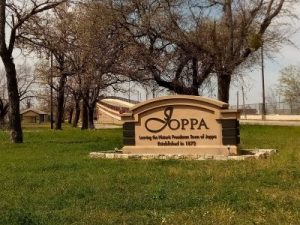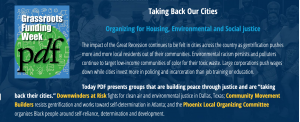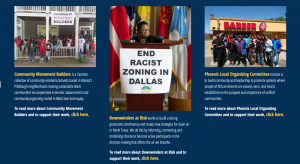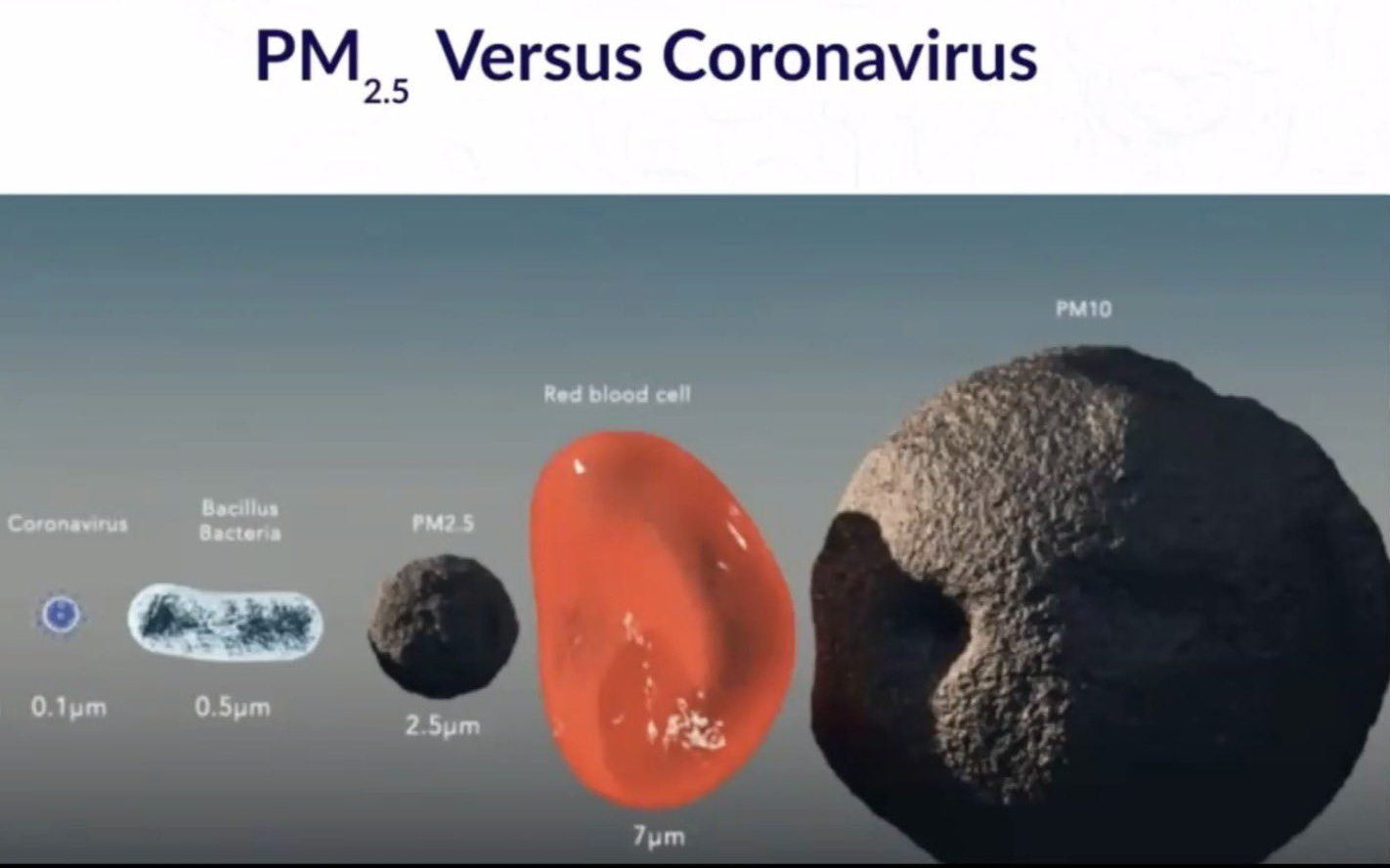Particulate Matter
Stay Inside. Plant Trees. An Annotated Guide to City of Dallas Air Quality Monitoring
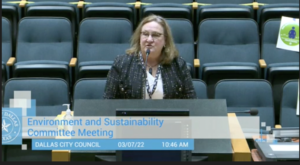
Over the last couple of weeks, the staff responsible for the Air Quality Department at Dallas City Hall’s Office of Environmental Quality have been making the rounds giving presentations about their official air quality monitoring efforts. You can find their complete PowerPoints here as PDFs on the agenda: https://cityofdallas.legistar.com/MeetingDetail.aspx?ID=903849&GUID=B69AEEB6-D5DA-4AE2-B8A4-5BB13C3FD4BE&Options=info|&Search=
The presentations are divided into two parts. The first deals with the monitors placed in Dallas as part of the State and federal enforcement to monitor DFW’s status as a “non-attainment area” for ozone, or smog. The second is about the “non-regulatory” (i.e not EPA-certified) air monitoring staff has been doing that has up to now has been going on under the “Breathe Easy” banner with a fleet of 12 monitors due to expire this year.
New federal grants have made it possible for the City to buy 35 new “non-regulatory” air monitors of various sizes and capabilities that are aimed at “community monitoring.” By the terms of the grants, five of these have to be placed in two West Dallas zip codes. The other 30 include six larger, more sophisticated air monitors that also come with their own metrological towers and will be placed at the City’s discretion.
This is quite an upgrade for a Department that only a short time ago was dismissing the idea of community monitoring and is in their fourth year of rejecting Joppa residents’ pleas for an air monitor in their neighborhood. That’s the good news.
What’s unclear is how all this new monitoring capability will be used to move the needle of air pollution exposure in Dallas.
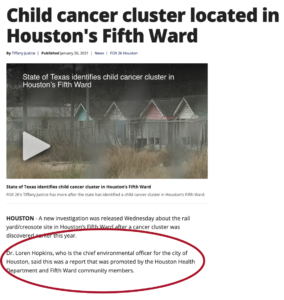
Houston has a staff toxicologist that identifies AND advocates for environmental health. Why doesn’t Dallas?
Is the City collecting air quality data so residents can brace themselves on “bad air days”, or are they collecting it to shape City Hall policy that could reduce air pollution and its impacts?
When the goals of all this City air monitoring come up in the new presentations, there’s no mention mention of impacting Dallas City Hall policy. Instead, there are boasts about gathering ““high quality data,” “contributing to local and regional databases,” and “better understanding the performance of low cost sensors” for “public health measures” and “understanding the role air pollution may play in pediatric asthma” (Really? there’s lots of studies already proving this link)
No suggestion for any pro-active City policy to reduce air pollution. No talking point about using the data to address environmental racism or increase City Hall’s much-valued “Equity” in air quality. There’s a lot of emphasis on collecting data but not much attention paid at all to what will be done with that data.
During the Question and Answer session that followed the presentations in front of the Dallas City Council’s Environmental Committee, staff suggested the results of the monitoring could be used to further the City’s air quality goals like…..staying indoors when pollution is bad, and planting trees to mitigate it. Honest.
Dallas City Council Member Jaynie Schultz:
“What are we going to do to reduce air pollution as a result of this data, this incredible trove of information we’re gathering? ….Will you be proposing to Council different things we can do to reduce that asthma so we can actually affect those numbers?
Office of Environmental Quality and Sustainability Assistant Director Susan Alvarez:
“We are currently working with our Office of Data Analytics to get that data added to the big data website so it will be publicly available. This is one piece of our grant for the West Dallas project; is to also develop appropriate messaging and to work with a non-profit on that to get that message into some of those schools where we have higher than average pediatric asthma rates….
CM Schutlz: But what’s the message? I’m sorry to interrupt.
Alvarez: The message is related to how to, um, best avoid, um, outside, outdoor activities. The other thing that we’re doing is working with the Texas Trees Foundation on, ah, piloting some interventions using nature based solutions, AKA, trees, and they’re working on that right now. They’re already working on planting vegetative screens”
It’s these kind of circa-1990’s answers that reveal why modern public health expertise is so needed at OEQS and City Hall. And not just included in the mix, buy actually driving City Hall environmental thinking. Data collection without application to policy is the Status Quo.
No OEQS staff holds a public health degree, has done research on the public health effects of air pollution, or is charged with evaluating air pollution levels from a public health perspective. When very high levels of air pollution are picked up by any of these new monitors, OEQS won’t have anyone on staff who’ll have the expertise to tell residents what that means.
Instead, the City will still be making residents do all the heavy lifting of solving problems the City helped create. You’re not only assigning them the task of linking pollution levels to impacts but also making it their responsibility to come up with the answer to cutting that linkage. This is what happened at Shingle Mountain. This is what’s happening in Joppa. This is what’s happening in West Dallas. Despite a fleet of new monitors, the City’s stance seems to be that we’re just collecting the numbers. What people do with them isn’t up to us.
Imagine that being the City’s response to finding levels of toxins in tap water faucets in Dallas neighborhoods. City Hall wouldn’t just publish the information in hopes of residents avoiding drinking the water. City Hall would take action to provide fresh water and eliminate the harm. But for some reason the City feels under no obligation to address toxic air quality in homes the same way.
There are a total of 20 slides in the two presentations. Here’s a brief annotated guide to the four slides that provide the crux of the City’s information:
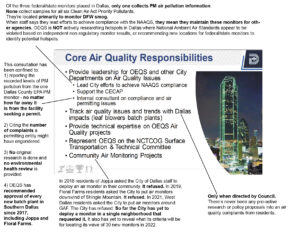
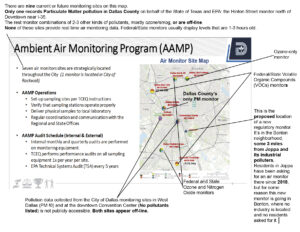
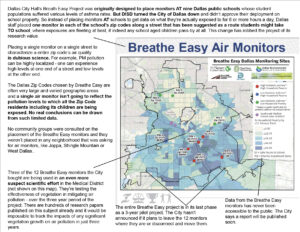
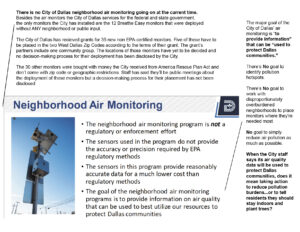
The City of Dallas’ approach to air pollution in its city limits is reminiscent of the old Community Organizing story about the village that finds abandoned babies floating downstream along its river banks and decides to organize to do something about it. At first there’s only a few, but after a couple of weeks there’s hundreds. Adoption bureaucracies are established. Seal Teams of Baby rescuers are on call 24/7. Special baby dams are built.
Until one day some smartass villager asks: “Why don’t we go upstream to see why the babies are ending up in the river?”
Dallas is always responding after the fact to air pollution problems in a downstream way when residents want them to go upstream and solve the real problems. Problems its often responsible for creating in the first place.
Instrumentation without context and action is pointless. “Neighborhood monitoring” without neighborhood oversight is worthless.
If the City of Dallas wants to maximize the potential of so many new air monitors, it needs real public health expertise to tell residents not just to avoid the danger, but how the danger can be eliminated. And neighborhoods must be driving its monitoring deployment process, not just informed after the fact or consulted on a token basis.
But right now there’s absolutely no process in place at Dallas City Hall to ensure either.
We Did This: A Shingle Mountain Clean-Up is Coming
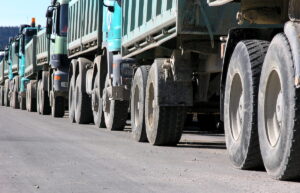
Despite the flurry of cynical and self-serving photo ops and press releases that Dallas City Hall churned out on Monday celebrating the beginning of a clean-up at Shingle Mountain, no waste was removed from the site yesterday. Nor will any be removed today.
But thanks to you, a clean up is coming. And also thanks to all you, that clean-up is suddenly more concerned with the health of Choate Street residents.
Last week, after a required 30-day public notice period, a state court approved a settlement between the illegal dump’s landowner, the State of Texas and the C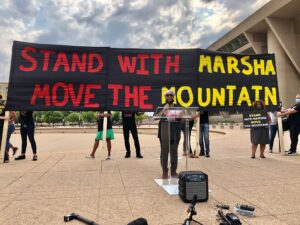 ity of Dallas that sets the table for removal of all “above ground” material. On Monday, contractors for the city were installing air monitors around the dump to record the levels of dust created when bulldozers begin loading the estimated 100,000 tons of hazardous waste into waiting 18-wheelers for the half mile trip to the McCommas landfill.
ity of Dallas that sets the table for removal of all “above ground” material. On Monday, contractors for the city were installing air monitors around the dump to record the levels of dust created when bulldozers begin loading the estimated 100,000 tons of hazardous waste into waiting 18-wheelers for the half mile trip to the McCommas landfill.
According to a separate agreement between the City and the landowner, the City has until December 25th to “begin” the removal process, i.e. sending trucks to actually haul off waste.
This result was anything but a foregone conclusion when the “Move the Mountain” campaign began last August 5th with a new conference at City Hall demanding the illegal dump be gone by the end of the year.
Only 4 months ago City Hall hadn’t made any commitments to a clean-up and had no estimate for when one would take place. The City Council had just unanimously rejected pleas from Choate Street residents to re-establish the Environmental Health Commission as part of a new Climate Plan. We were at a low ebb in our campaign.
But a strategic and constant barrage of public protest and shaming – mock trials, leafleting the Mayor’s law firm, 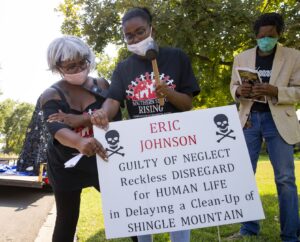 dumping waste at City Hall – along with the attendant embarrassing media coverage, made the City of Dallas actually commit itself to a clean-up it hadn’t planned on doing quite as fast, if at all.
dumping waste at City Hall – along with the attendant embarrassing media coverage, made the City of Dallas actually commit itself to a clean-up it hadn’t planned on doing quite as fast, if at all.
Keeping constant pressure applied for four months was often exhausting, but momentum grew with each new demonstration. November 16th might have seen “peak” Shingle Mountain coverage with publication of a long and well-written expose in the Washington Post, a public demonstration at the dump’s gate counting down the days until a clean-up was supposed to begin and a crew from Solodad OBrien’s upcoming BET documentary in town to film it for a premiere in February.
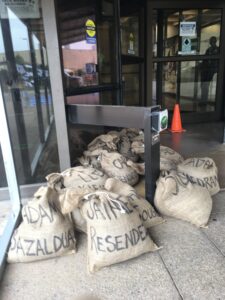 Thanks to everyone who showed up to those demonstrations of support. Whether you attended one or all of them, your presence made a difference.
Thanks to everyone who showed up to those demonstrations of support. Whether you attended one or all of them, your presence made a difference.
Those of you who sent in public comments this last month also had an impact. Initially, neither the State nor City expressed the least bit of concern about the health of Choate Street residents during the messy business of removing the waste. No specific provisions for controlling dust or monitoring air quality were included in the City agreement or State settlement.
But after over 50 letters and emails worth of comments were sent and included in the public record, the City suddenly got religion. It included dust control measures and air monitoring in its final description of the clean-up to the court. Lawyers for Marsha Jackson, Co-Chair of Southern Sector Rising, and a Downwinder board member cited your public comments as the reason the City included these new safeguards at the last minute. So congratulations a second time.
Now what?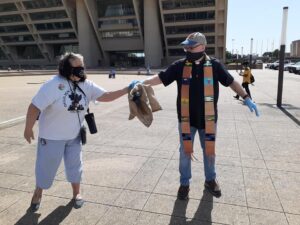
The settlement and agreements signed by the State and City are vague about what happens after the land surface is cleared of waste. Will there be any monitoring wells drilled to see if contamination seeped into the groundwater? Will the clean-up extend below the ground as well as above if the soil is contaminated? If pollution is found in the soil or water, what level of contamination is “acceptable”, i.e. what are the clean-up levels then?
And what and who will be responsible for the health costs -financial and physiological – accumulated by Ms. Jackson and the other Choate Street families?
Residents have drafted their own neighborhood plan for redevelopment that drastically changes the zoning in their community. They’ve submitted it to City Hall. But the same City Council Member that was taking unearned credit for Shingle Mountain’s removal on Monday is fighting this neighborhood plan tooth and nail.
District 8 City Council Member 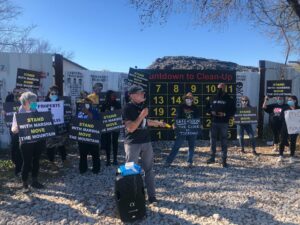 Tennell Atkins is one of the biggest reasons Shingle Mountain exists at all, and why its removal has been so delayed. He’s been nothing but an obstacle to be overcome instead of an ally for his constituents. Adding insult to injury, he’s now standing in the way of Choate Street and Flora Farms residents being able to rebuild their community from the devastation he’s inflicted on them.
Tennell Atkins is one of the biggest reasons Shingle Mountain exists at all, and why its removal has been so delayed. He’s been nothing but an obstacle to be overcome instead of an ally for his constituents. Adding insult to injury, he’s now standing in the way of Choate Street and Flora Farms residents being able to rebuild their community from the devastation he’s inflicted on them.
Atkins is up for re-election in May and it’s our hope that all of you who made this Shingle Mountain clean-up happen will stick around and finish the job by helping us remove this political tumor that threatens the future of Southern Dallas.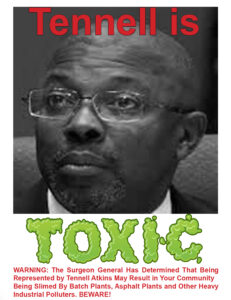
Sunday December 13th was the two-year anniversary of the very first Robert Wilonsky column about Shingle Mountain in the Dallas Morning News. Some of us believed that first column would expose the problem and move officials to act to resolve it. 13 Wilonsky Shingle Mountain columns later, we’re still waiting on the trucks that should have arrived in January 2019.
If they show up before Christmas Day , it will be one of the best, most satisfying moments of a terrible year. But it won’t be the end of the struggle over racist zoning that began on Choate Street. That struggle is just beginning.
Robert Wood Johnson Foundation awards grant to Texas A&M and Downwinders at Risk for Joppa Environmental Health Project
Monies will fund unprecedented study of link between health and air pollution in Dallas Freedman’s Town; first effort of its kind in Texas
What’s believed to be the single largest environmental health research investment in a Texas neighborhood was awarded today by the Robert Wood Johnson Foundation to examine the links between human health and air pollution in the Joppa community of Dallas.
 Texas A&M and Downwinders at Risk’s Joppa Environmental Health Project was selected as one of only 16 national proposals funded by the Foundation’s Interdisciplinary Research Leaders grant. Between now and 2022, over $350,000 will be spent by Texas A&M scientists trying to understand the correlation between Particulate Matter air pollution and the health of the Freedman’s Town’s residents.
Texas A&M and Downwinders at Risk’s Joppa Environmental Health Project was selected as one of only 16 national proposals funded by the Foundation’s Interdisciplinary Research Leaders grant. Between now and 2022, over $350,000 will be spent by Texas A&M scientists trying to understand the correlation between Particulate Matter air pollution and the health of the Freedman’s Town’s residents.
Cecilia Wagonner, a member of the Joppa church that hosted a community meeting on air pollution monitoring last December, was enthusiastic about the news. “I want to know the truth and nothing but the truth about air quality in our historic neighborhood. This is definitely good news. Let environmental justice be served.”
Per capita, Joppa is the most polluted neighborhood in Dallas. On one side is the Trinity River. On the other three sides are an asphalt batch plant, Railroad switch yard, large asphalt shingle factory, a concrete batch plant, and Interstate highway. It’s directly downwind from the largest methane air p olluter in Dallas – the City’s McCommas Landfill methane energy recovery unit.
olluter in Dallas – the City’s McCommas Landfill methane energy recovery unit.
Since PM air pollution monitoring began there on August 31st as part of the new SharedAirDFW air monitoring network, Joppa’s PM levels have averaged significantly higher than other sites.
Two Texas A&M scientists based in College Station will lead the new Project. Dr. Natalie Johnson, is an A&M toxicologist specializing in the health effects of Particulate Matter air pollution, and Dr. Ping Ma, is an A&M behavioral and social science researcher who previously worked at Dallas Children’s Hospital specializing in health disparities and social determiners of health. Downwinders will assist with community canvassing and outreach efforts as well as provide technical support through its 11-Joppa based SharedAirDFW network monitors.
They’re now all charged with collecting evidence to discover whether Joppa has higher rates of PM air pollution and health problems than other communities, and understand how differences in daily levels of PM affect residents’ health.
“PM represents a significant ‘unseen’ health risk related to cardiovascular disease, chronic respiratory disease, including lung cancer and asthma, as well as effects on infant development and brain health,” said Johnson. “SharedAirDFW’s real-time pollution monitors will help make this threat ‘seen.”
Ping pointed out the study will be the first academic-community collaboration of its type in Texas. “Our findings will facilitate understanding of the air pollution risks Joppa residents face as well as generate community-based solutions to help create a new culture of environmental health in Joppa.”
Participa nts chosen for the IRL process also become students who receive training in the latest research methods and constant feedback from panels of experienced scientists and experts.
nts chosen for the IRL process also become students who receive training in the latest research methods and constant feedback from panels of experienced scientists and experts.
Grant monies will pay for staff time, graduate assistants, technology, travel, and community outreach over a three-year period.

The IRL grant is the first research project attracted by the SharedAirDFW regional air monitoring network that debuted in September, but Jim Schermbeck, Director of Downwinders, predicted it wouldn’t be the last. “This network makes all kinds of new comparisons and studies possible. In this case, residents and researchers are using it to document Joppa’s air pollution burdens and assist residents in relieving those burdens. That’s a first for Dallas, and Texas.”
From now until the end of the year the Project partners will be assembling their local contacts, refining their timeline and methodology, and getting ready to begin research in early 2021.
A Citizen’s Guide to a Citizen’s Air Monitoring Network
When you click on the new SharedAirDFW.com site, the default setting shows you the location of the SharedAirDFW monitors and the real time wind direction and speed.
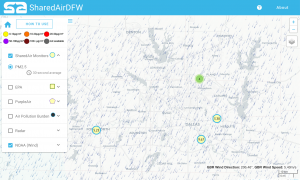
The Menu gives you a choice of three different PM monitor networks to look at: SharedAirDFW, the EPA, and Purple Air. You can look at them one at a time or all at once.
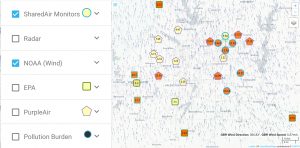
The menu also allows you to see where all the major air pollution permits are located in the City of Dallas. Click on the black dot and it reveals the name of the air pollution permit holder as well as the volume of pollution in tons per year reported in 2018 (the last fully reported year). We only have this mapped inventory of air polluters because of the Paul Quinn College report “Poisoned by Zip Code.” The City of Dallas has no such inventory or map.
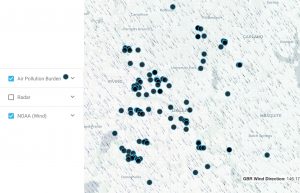
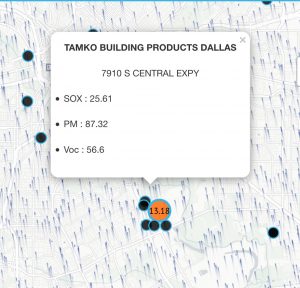
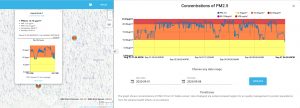
Joppa Air Monitor Already Providing Evidence of Why It’s Needed
Since it began collecting data on the afternoon of August 31st, the Joppa Zion Mothership monitor has consistently recorded the highest average levels of PM among all the deployed SharedAirDFW monitors, as well as all EPA and Purple Air monitors in DFW. These bar charts show the level of PM recorded from most of the current SharedAirDFW network monitors from 8/31/20 to 9/14/20. They’re all accessible to the public through the site.

A New Era for DFW Air Quality and Downwinders at Risk
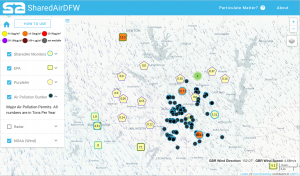
The SharedAirDFW network map displaying monitors from all three monitor networks and major Dallas air polluters identified.
The debut of the SharedAirDFW Network means
21st Century air monitoring finally arrives in North Texas
After three years, and many thousands of hours and dollars, citizens have their own
regional air quality monitoring system.
It’s easy to use, operates in real time, and its monitors are being put where the pollution burdens are greatest.
The Joppa Zion Mothership Monitor: on the Network’s digital map and on its pole after deployment.
Since operation began 8/31, it’s consistently shown higher levels of PM air pollution than other monitors in Dallas.
By January they’ll be 11 more monitors joining it in the Freedman-founded community.
A three-year high-tech collaboration between the University of Texas at Dallas, Downwinders at Risk, the City of Plano, Dallas County, Dallas College, and Paul Quinn College came to fruition today with the official debut of the the SharedAirDFW Network – online, and with an outpost in one of the most polluted neighborhoods in North Texas.
It becomes the first and only regional “hyper-local” air monitoring network in Texas and one of the only ones being built by any US city.
“This network is the purest, most dramatic expression of our 26-year old goal to provide citizens with the tools government won’t,” said Downwinders Director Jim Schermbeck, who’s helped shepherd the Network since it was a National Science Foundation grant runner-up in 2017. “We see SharedAirDFW’s debut as the public health equivalent of turning on electric streetlights for the first time at the turn of the 20th Century. We’re building a utility – the full impact of which won’t be realized for years.”

Dave Dabadeen, Kevin Owen, and Jay Smith – our monitor installation team, deploying one of 11 solar powered satellite monitors in Joppa.
Debuting with eight Particulate Matter (PM) air pollution monitors located from Richardson to Southern Dallas and Mesquite to Fort Worth, the network is scheduled to install over 100 more in the next 12-24 months, including blanketing Dallas neighborhoods whose residents say they’re already breathing bad air but have no way to prove it.
In the last decade published research on the human health effects of exposure to Particulate Matter air pollution has linked it to a variety of illnesses and diseases, including developmental impacts such as Autism, Parkinson’s, Dementia, and IQ loss. These effects have been documented at exposure levels well below U.S. EPA regulatory limits.
All the monitors in the network were built at the Physics Laboratory at the University of Texas at Dallas campus in Richardson. They’re being distributed to members either in clusters of 11, with one larger hard-wired “Mothership” accompanying ten smaller solar-powered ones or the Mothership as its own stand alone unit.
ALL DFW PM MONITORS DISPLAYED ON A SINGLE MAP
PM Air pollution data collected from those monitors, along with information from EPA and DFW Purple Air monitors, are displayed in real time on a digital map accessible to anyone online at www.sharedairdfw.com. For the first time, a single website displays all the online monitors networks collecting PM air pollution data in North Texas on the same map. Besides UTD, Downwinders at Risk, Dallas College, and Dallas County will be displaying the SharedairDFW map on their own websites.
Only Particulate Matter air pollution levels are shown by the SharedAirDFW map now but larger monitors will also be capturing Ozone, or Smog levels. At some point in the near future, that data will also begin to be displayed on the Network map.
MAPPING OF MAJOR POLLUTERS
Also on display are the locations of the major air polluters in the City of Dallas, along with their self-reported pollution volumes – a first-ever inventory of Big D’s air polluters that no level of government currently provides.
MANY MORE M ONITORS IN MANY MORE PLACES
ONITORS IN MANY MORE PLACES
Currently there are only six EPA monitors for Particulate Matter Air pollution in all of North Texas, and only 12 Purple Air monitors online. With the ability to saturate neighborhoods with almost a dozen monitors apiece, SharedAirDFW allows residents, researchers, and policymakers to better pinpoint pollution plumes and health risks.
REAL TIME DATA
For the first time there’s a way for DFW residents get air quality information in real time instead of waiting for up to two or three hours at government monitor sites. The SharedAirDFW monitors display their readings every 30 seconds, 24 hours a day.
AN EMPHASIS ON ENVIRONMENTAL JUSTICE
For the first time there’s year-round, calibrated air quality data being collected in Dallas’ most polluted neighborhood – the Joppa community in Southern Dallas along the Trinity River. The “Joppa Zion Mothership” – named for the adjacent Church – began transmitting on Monday August 31st. It’s linked to two additional “satellite” monitors that began transmitting this last weekend. By January they’ll be 11 monitors in Joppa, making it the most densely monitored neighborhood not just in Dallas, but all of Texas.
Joppa’s monitors are the first of 33 air monitors Downwinders at Rik is deploying in so-called “fence line” locations. After installation in Joppa is completed, another 11 will be installed in West Dallas, and then in and around Midlothian as well.
In the two weeks since the first Joppa monitor was installed, it’s consistently recorded higher levels of PM pollution than other monitors in the SharedAirDFW network as well as local EPA and Purple Air monitors. Schermbeck said those results vindicate the decision to locate monitors in predominantly Black and Brown neighborhoods disproportionately burdened by their proximity to industrial polluters. “Our monitors are going where people are most harmed by air pollution, but least able to do something about it.”
James McGuire has Left the Building, But Will Dallas’ City Hall Continue to Neglect Environmental Health and Justice Remain?
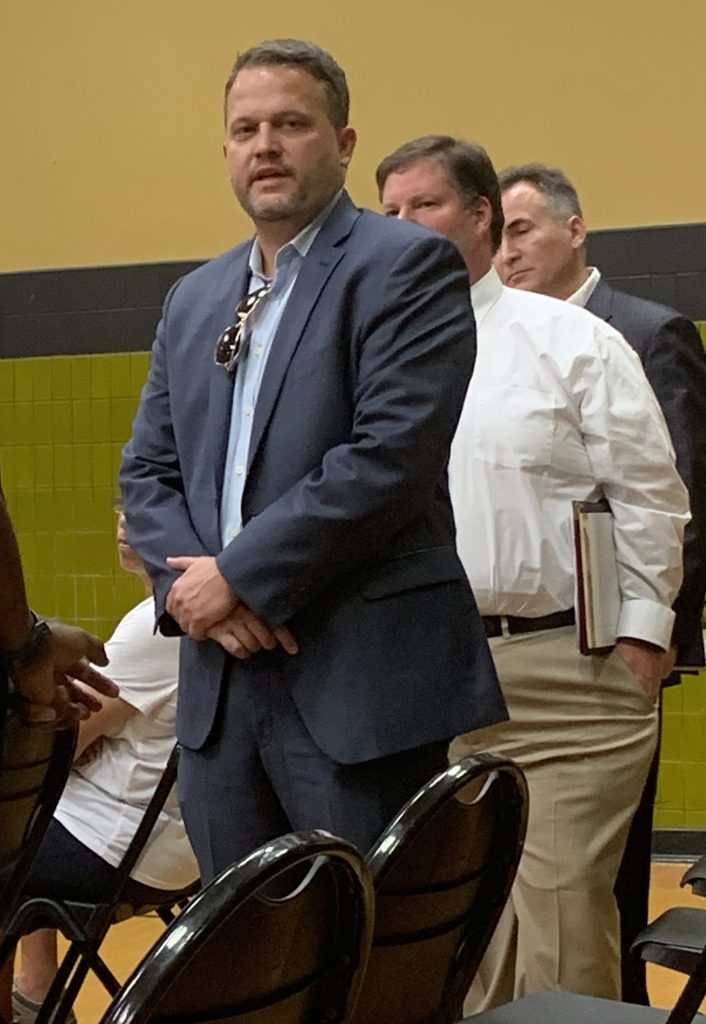
Friday was reportedly James McGuire’s last day as Dallas’ Director of the Office of Environmental Quality and Sustainability. He’s said to be taking leave for the rest of July and then he’ll move on…to a position at the Trump EPA. After serving for sometime as an “Interim Director,” he’d been the real thing for the last three years.
McGuire’s departure comes almost a month before the unveiling of the implementation schedule of his crowning achievement, Dallas’ Climate Plan, in front of the City Council. Speculation about his leaving ranges from this being a done deal triggered by the Climate Plan’s passage in May, to being fallout from the City being included as a defendant in Marsha Jackson’s Shingle Mountain lawsuit two weeks ago.
During his tenure McGuire, a City attorney who got assigned the OEQS position, earned kudos for policies that directly affected internal City operations – where and how the City bought electricity for it’s facilities, or how efficiently city operations saved water.
But almost every time he stepped outside of City Hall into public policy his record has been a disaster, especially for Southern Dallas.
Time and again, when McGuire had the chance to help Southern Dallas residents, he turned his back, or worse, contributed to the problem they were complaining about. A short list of his “greatest misses” includes:

- Promotion of Batch Plants in Southern Dallas. In 2018 and 2019 four separate batch plants were trying to win permission from the city to locate in already overburdened Joppa and Flora Farms (Shingle Mountain). McGuireand OEQS endorsed all of them. But much worse was McGuire’s purposely misleading statements about current air quality in Joppa during the Council’s debate on the permits. Asked if current Particulate Matter pollutant levels in Joppa should be of any concern, McGuire disingenuously said EPA monitors “in Dallas” showed levels “meeting national standards.” It wasn’t until a pointed follow–up question from a Council Member reveled the cynicism of his answer: the nearest (and only) EPA PM monitor was nine miles away, on the other side of downtown. Residents defeated all four batch plant permits despite OEQS’s endorsement.
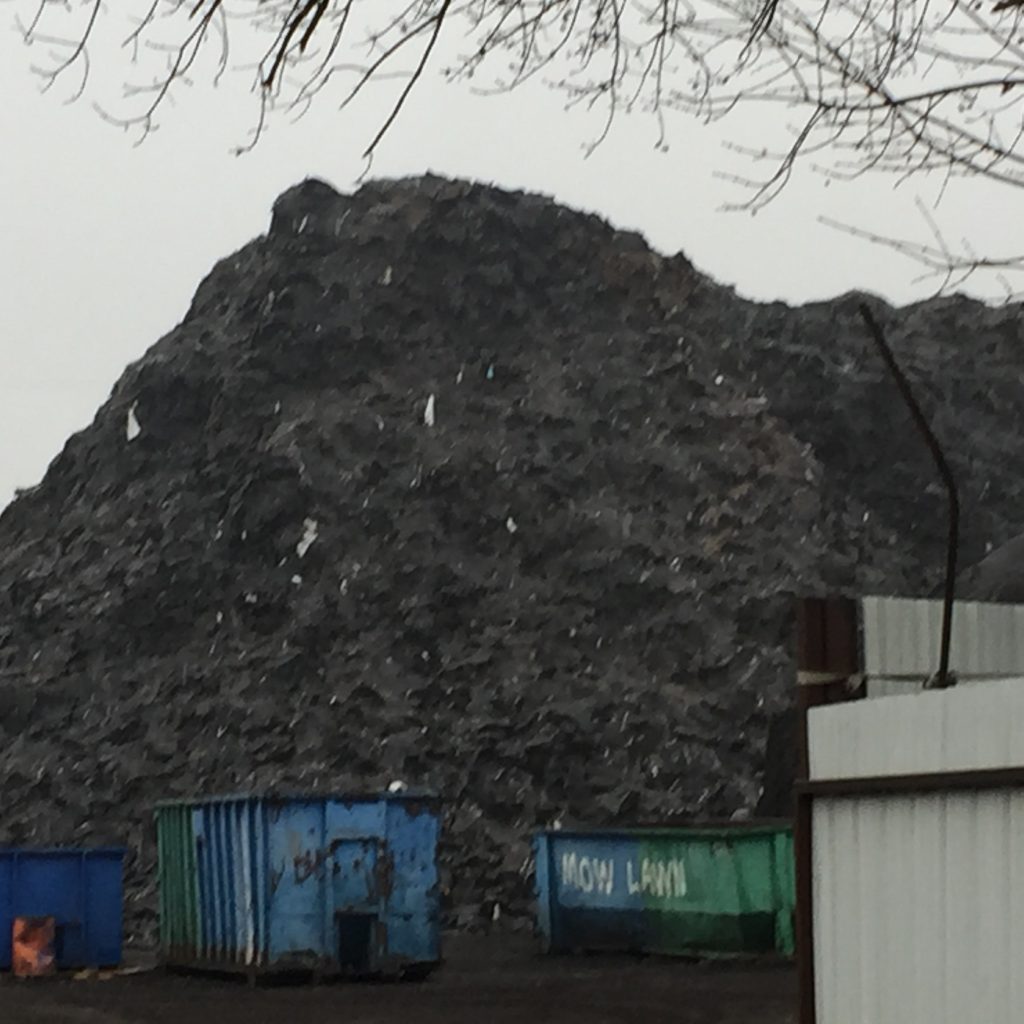
- Creation of Shingle Mountain. The six story 100,000 ton illegal dump – Dallas’ largest and most dangerous – was over a year and a half old and was violating a multitude of laws and regulations with impunity when McQuire first learned about it from DMN columnist Robert Wilonsky. The most notorious environmental justice disaster in Dallas in 25 years happened on his watch without him or anyone in his department noticing. Compounding this mistake – which nobody has every apologized for – was the OEQS’ absolute obsession with storm water non-compliance issues at the dump to the exclusion of any concern for adjacent residents’ health from fumes or particulate matter containing carcinogens. At no point over the last two years has McQuire or OEQS said anything about how toxic the dump is to human health, but he and the Department have been very, very concerned about illegal storm water runoff.
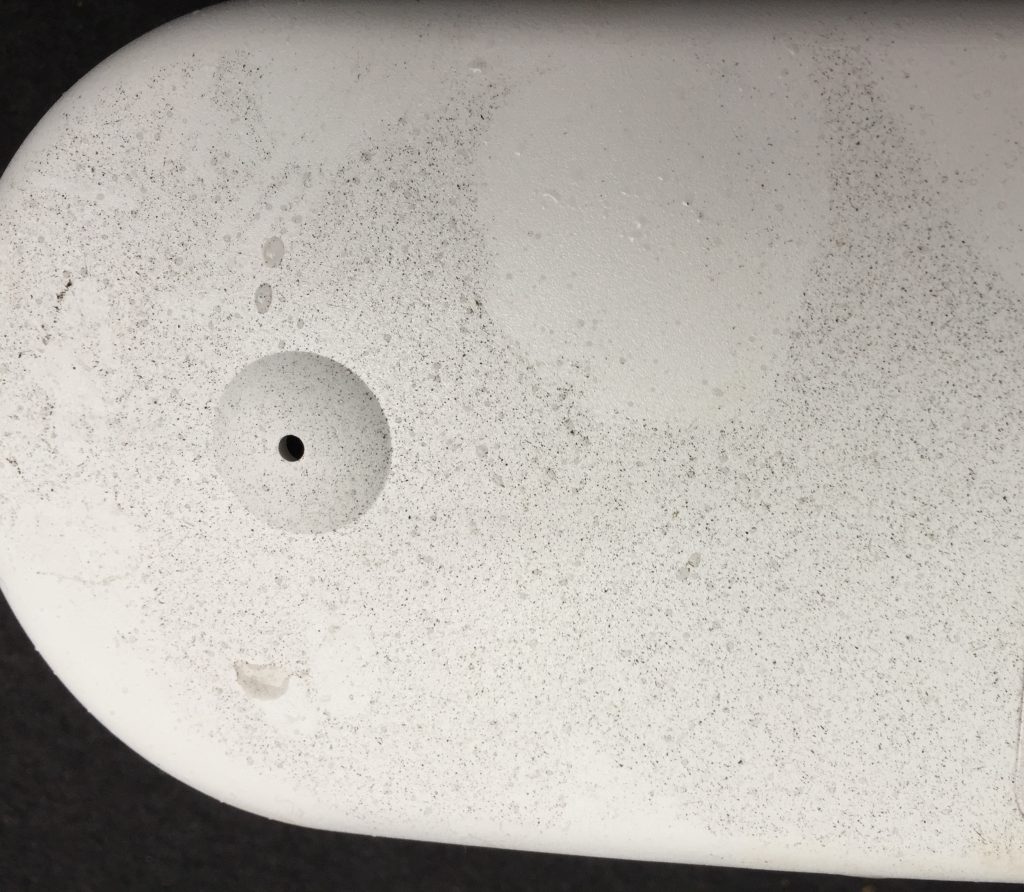
- Denying pleas for air quality monitoring from residents of Joppa and Shingle Mountain. In 2018 OEQS representatives rejected Joppa residents’ request that the City provide air quality monitoring – even after portable monitor readings by Downwinders found high levels of PM pollution there, and even though the City had the monitoring equipment to do so. McGuire and OEQS also tuned down Marsha Jackson’s pleas to do air monitoring at her house under the six-story Shingle Mountain illegal dump, even though Downwinders’ portable monitors placed on her windowsill were completely covered in a black dust and recorded hazardous levels of PM pollution.
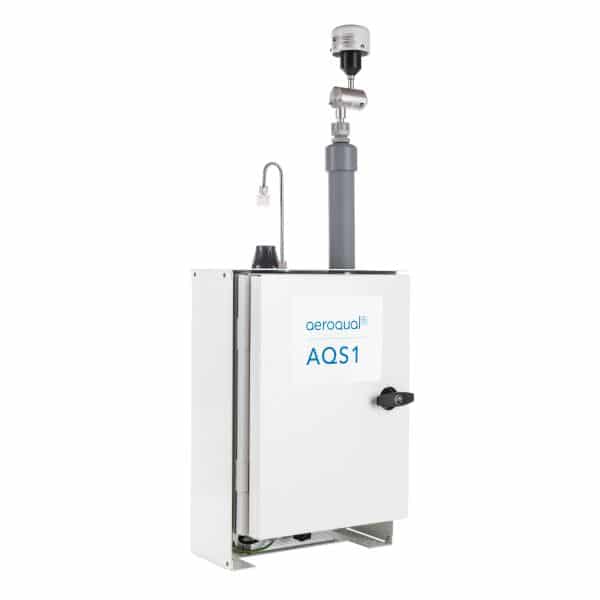
- The collapse of the City’s “Breathe Easy” air monitoring initiative. After planning for years to deploy 10 to 12 air monitors at public schools in Dallas, the City finally identified the schools it wanted to participate, bought a dozen new Aeroqual air quality monitors, and then informed DISD of its intent. DISD said no thanks; they didn’t want the monitors on school property. The 12 brand new monitors are sitting in a closet somewhere unused. And by the way, no one would know about this epic fail if Downwinders hadn’t fought tooth and nail through the Texas Open Records Act to get the documentation. DISD’s rejection was already a done deal when OEQS staff gave a briefing to City Council on the project…but neglected to mention that the school district had rejected the idea. Some folks would call that a cover-up.
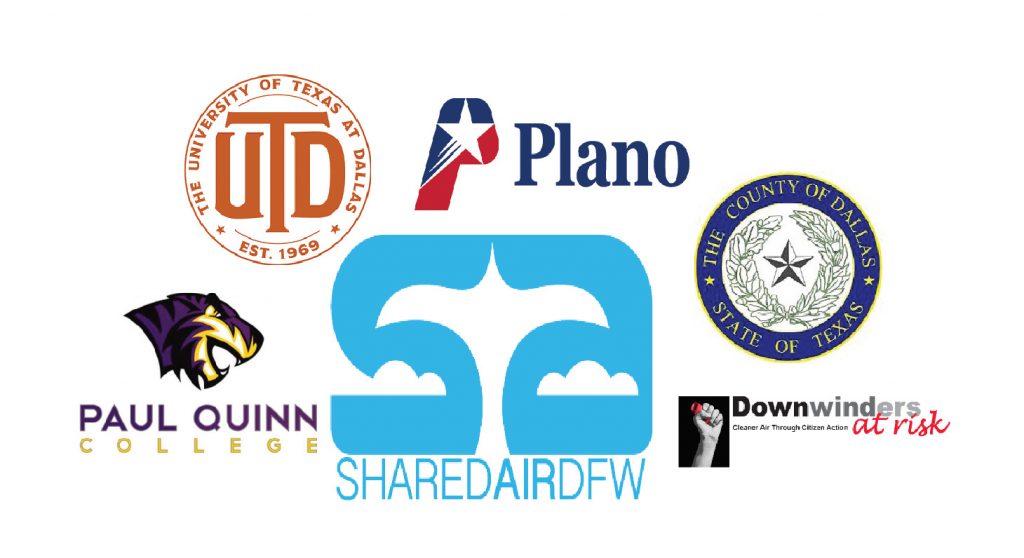
- Withdrawing from the SharedAirDFW Community Air Monitoring Network. Before he began the City’s own Breathe Easy project, McGuire and Dallas was part of group working to build a regional air monitoring network that included Plano, Dallas County, Dallas County College, Paul Quinn College, and area school districts among others. After participating in the Network for a year, he and the City abruptly withdrew their support when a proposed governing structure for the Network required citizen participation. All the other entities stuck around ,and the first SharedAirDFW monitors are about to go online in the next 30-45 days. Meanwhile the rival Breathe Easy effort McGuire invented to avoid public participation went bust. He single handedly set the City of Dallas back years on this front.

- Using a “compliance is protection” defense to avoid talking about environmental health issues. There’s now a decade of scientific evidence that connects exposure to levels of pollution far below the “national standard” set by EPA to serious health injury, including early death. But McGuire and OEQS never acknowledged this evidence. Not once. Instead, as long as the one (!) PM monitor in Dallas showed levels that were within the obsolete 24 hour or yearly standard enforced by EPA, the conclusion was always that “Dallas was in compliance.” But science says compliance isn’t protection. Houston’s environmental department employs a toxicologist who goes to Black and Brown neighborhoods where batch plants are being proposed and tells residents there’s no safe level of exposure to PM pollution. Dallas had a lawyer who stayed in his office, spoke of “compliance,” and approved them.
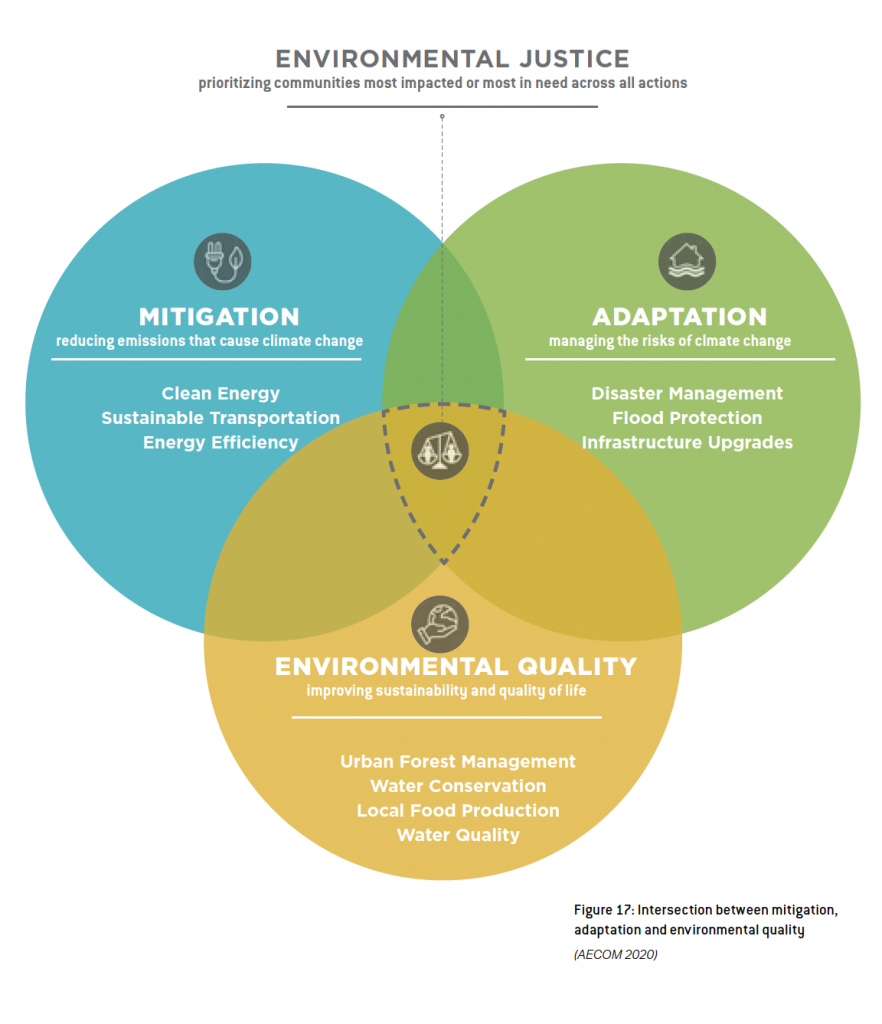
- Using race-neutral language to to discuss racist environmental justice issues. Although the OEQS probably used the word “equity” more than any other city department in its presentations, it refused to acknowledge that racist redlining, zoning, and decision-making underlies much of Southern Dallas’ pollution problems. Instead, it used all kinds of euphemisms for “racist” to describe the predicament of Joppa and Shingle Mountain residents. When the City’s Climate Plan came to dealing with environmental justice, it threw away the original race-based definition by Dr. Robert Bullard, the guy who invented the phrase, and adopted a consultant’s definition that ignored any mention of race. Nobody but Southern Dallas residents noticed. Oh yeah, it also mentioned water conservation, but not clean air.
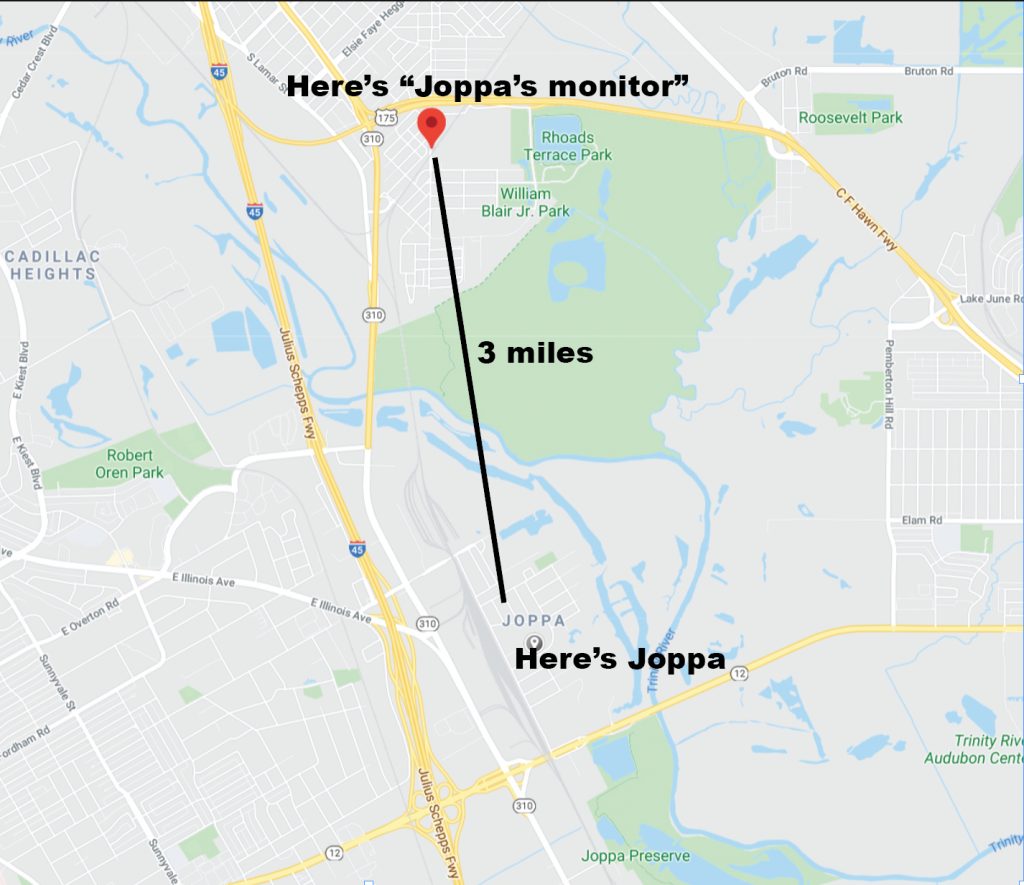
- One of his final acts as OEQS Director was also one of McGuire’s most cynical, which is saying a lot. In June he and his staff hailed the official announcement of the City’s deployment of a single PM monitor “in Joppa” when in fact the monitor is located three miles north of the former Freedman’s town in the entirely separate neighborhood of Bonton. In one of the most up-is-down moments of McQuire’s administration, OEQS staff actually told their audience of impressed Council Members that a monitor located three miles away from the closest source of Joppa industrial pollution would be better able to capture that pollution than it would across the street in Joppa itself. They presented no evidence to prove that absurd claim, most likely because it runs contrary to the last quarter century of actual science. But that evidence was ignored to try to make the City look like it was doing something it was not.
With a record like that you wonder how the guy kept his job as long as he did until you realize almost all of his sins were committed against Southern Dallas and People of Color. When it came to things like the City’s feeble Climate Plan that North Dallas white environmentalist were craving, he was an ally. But none of those folks lived in neighborhoods with a batch plant or a illegal dump. Their support came cheap and was completely disconnected from reality on the ground in Southern Dallas.
In choosing McGuire’s replacement there’s a chance to change the way the City of Dallas looks at environmental issues. Fundamental to this change must be inclusion of “environmental health” as a primary focus. The goal must not be just to comply, but to protect.
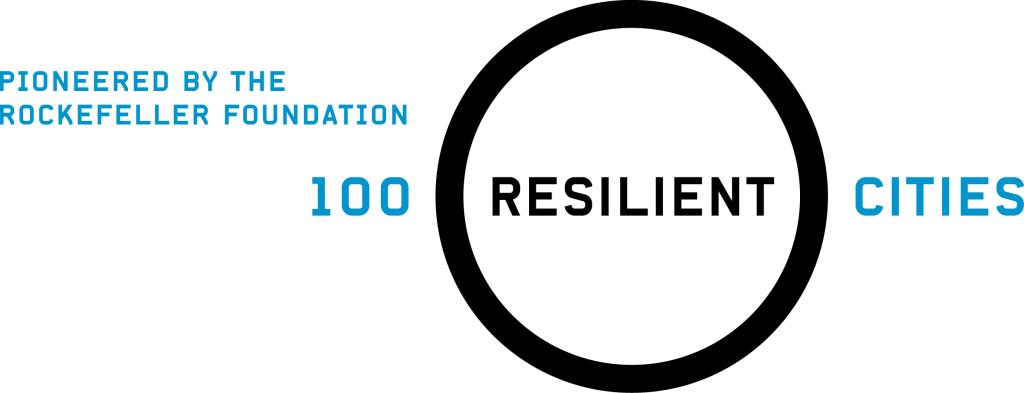
For the past five years or so “resilence” and “sustainability” have been the hot code words for action surrounding green issues. Fueling this semantic change was the Rockefeller Foundation, that for awhile was giving huge grants to every city that would commit itself to a resilency planning. Dallas chased and got that money and so has a “Resilency Plan” that you’ve probably never seen, out of which sprang the City’s Climate Plan. But that Rockefeller money has stopped flowing and so “resilency” is suddenly getting a lot less play.
Now it’s “sustainability.” Still chasing grant dollars, the City practically tripped over itself in swiftly changing the name of the “Office of Environmental Quality” to the “Office of Environmental Quality AND Sustainability” and created a while new Council “Committee on the Environment AND Sustainability.”
But more often than not “Sustainability” doesn’t include environmental health. Sustainability is water conservation, or tree cover, or renewable energy. It isn’t fighting batch plants, racist zoning, or reducing the health damage caused by pollution meeting the national standard by way of a monitor on the other side of town. “Sustainability” is a word that takes the emphasis away from the goal of better human health and puts it on abstract policy goals. That makes it a red flag for People of Color whose health suffers disproportionately from pollution. It signals yet another detour away from addressing their daily poisoning.
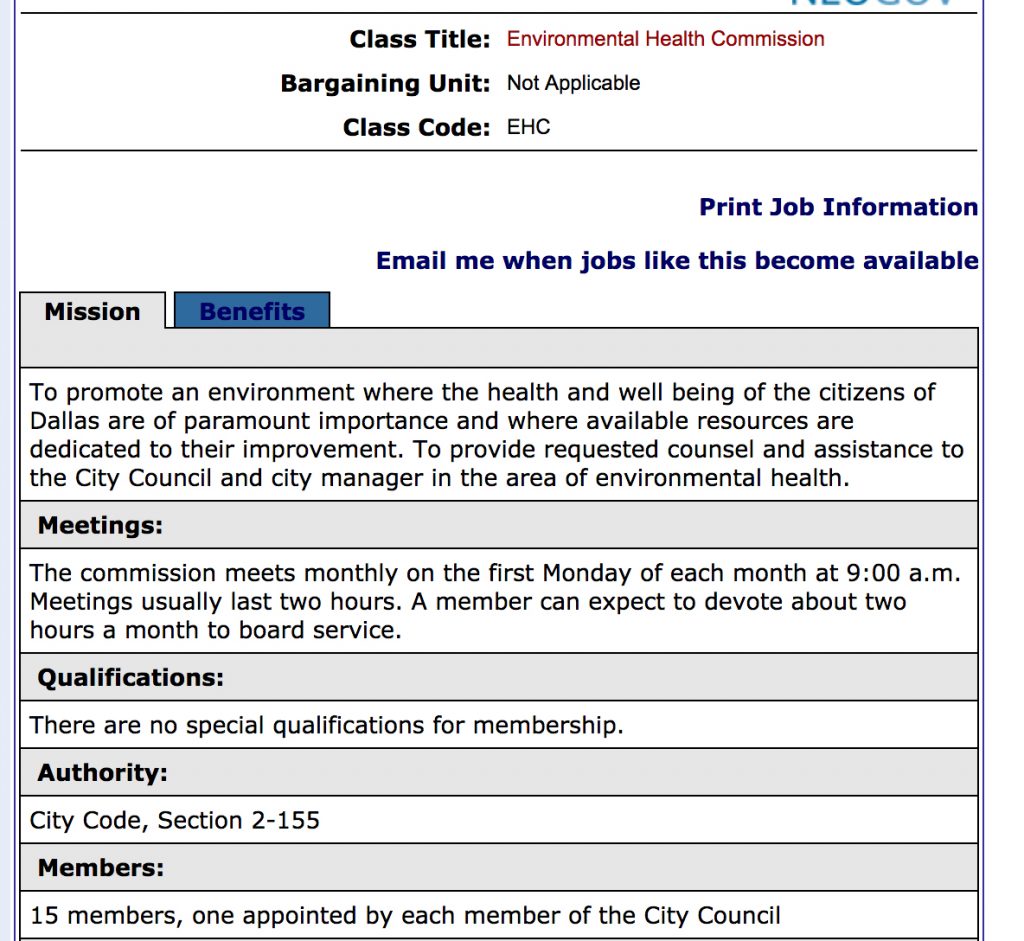
That’s why Downwinders and Southern Sector Rising fought for inclusion of the words “environmental health” in the City’s Climate Plan back in May. But not even a single Dallas City Council Member would agree to include it. So they’ll be yet another City Committee formed to address “sustainability” but not one that has environmental health in its mission.
Now City Hall has a chance to send a message that they’re listening; to make a break with the status quo that produced that long and undistinguished record above. The new OEQS Director could be a turning point…or just another brick in the wall.
Downwinders is advocating McGuire’s replacement should be at least two things: 1) a Person of Color, and, 2) a scientist, preferably a toxicologist, epidemiologist, or public health specialist. No more lawyers.
OEQS needs a fresh new face. One that isn’t already weighted down by City Hall baggage. Black and Brown scientists are likely more qualified to address environmental health injustices in Dallas due to their perspective on race and the environment, and therefore should be proactively recruited for the job” Their perspective is desperately needed at Dallas City Hall.
But a new bio at the top won’t do Southern Dallas much good unless the mission of the OEQS changes as well.
Before McGuire, it was commonplace for environmental health issues to be addressed by the City – either through the former Environmental Health Commission or campaigns like the one then Mayor Laura Miller mounted against a wave of new coal plants being pushed by Rick Perry. McQuire’s neglect of environmental health is the anomaly here, not the other way around.
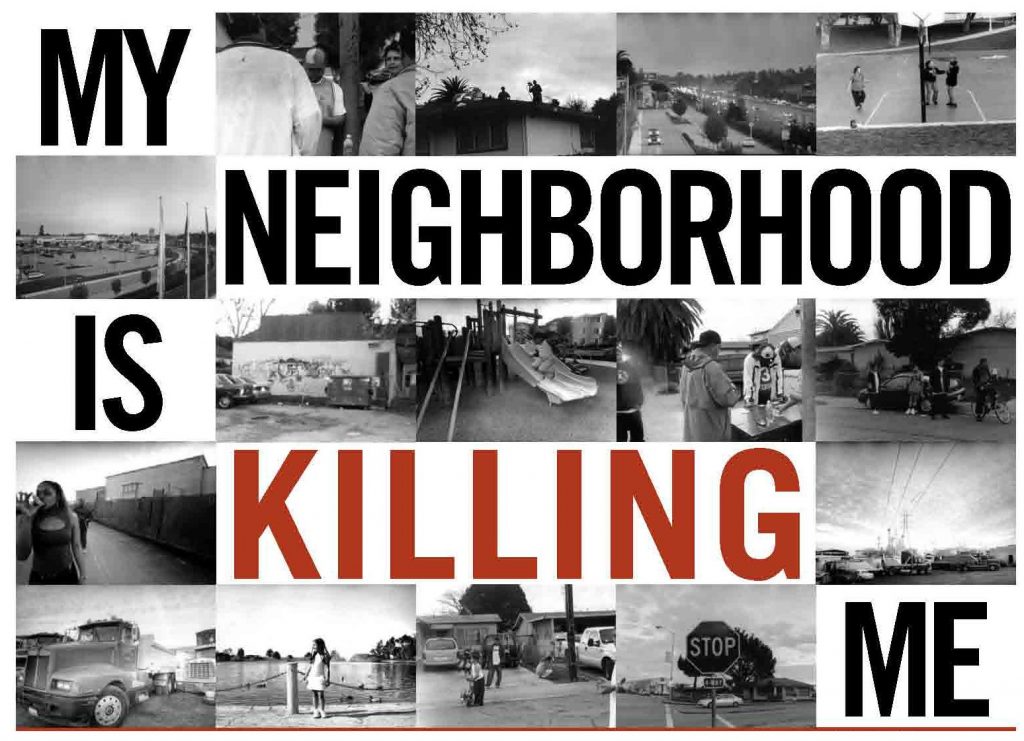
That kind of pro-active approach needs to be restored, if only to head-off problems before they become lawsuits. The new OEQS Director should feel free to speak about what the science says, and fully embrace public health considerations, not dodge them.
Given the context of the last two months of national uprisings, the situation on the ground and in the courts at Shingle Mountain, plus the rapidly advancing public dialogue on all things Race, the OEQS needs to come to terms with its role as a public health arbiter for Southern Dallas. It would be great if this next Director saw their job as working to reduce environmental health damage there instead of trying to cover it up.
National Fund Spotlights Downwinders’ Efforts to “Take Back Our Cities”
Today, the Peace Development Fund is using its national presence and contacts to help raise funding for Downwinders at Risk, under the banner of “Taking Back our Cities.”
We’re being featured on their website all day. We’re one of only 13 groups chosen to receive this kind of attention from the Fund.
The Fund liked our work around the upcoming Dallas MasterPlan process, partnering with Southern Sector rising and neighborhood groups to rezone Southern Dallas communities tract-by-tract to improve environmental health.
We’re one of the few environmental groups in the country using land use planning tools to reduce residents’ exposure to pollution. Our aim is to dismantle the racism institutionalized in local zoning codes that have forced People of Color and industry to live side-by-side for decades.
Many of you helped us reach our Giving Day goal. But we need those of you who didn’t contribute on Giving Day to do your part today. Here’s your chance to join the fight for cleaner air and environmental justice.
Thanks.

Director

____________________________________
COVID Connects:
Racist Zoning
to
Increased Vulnerability to COVID
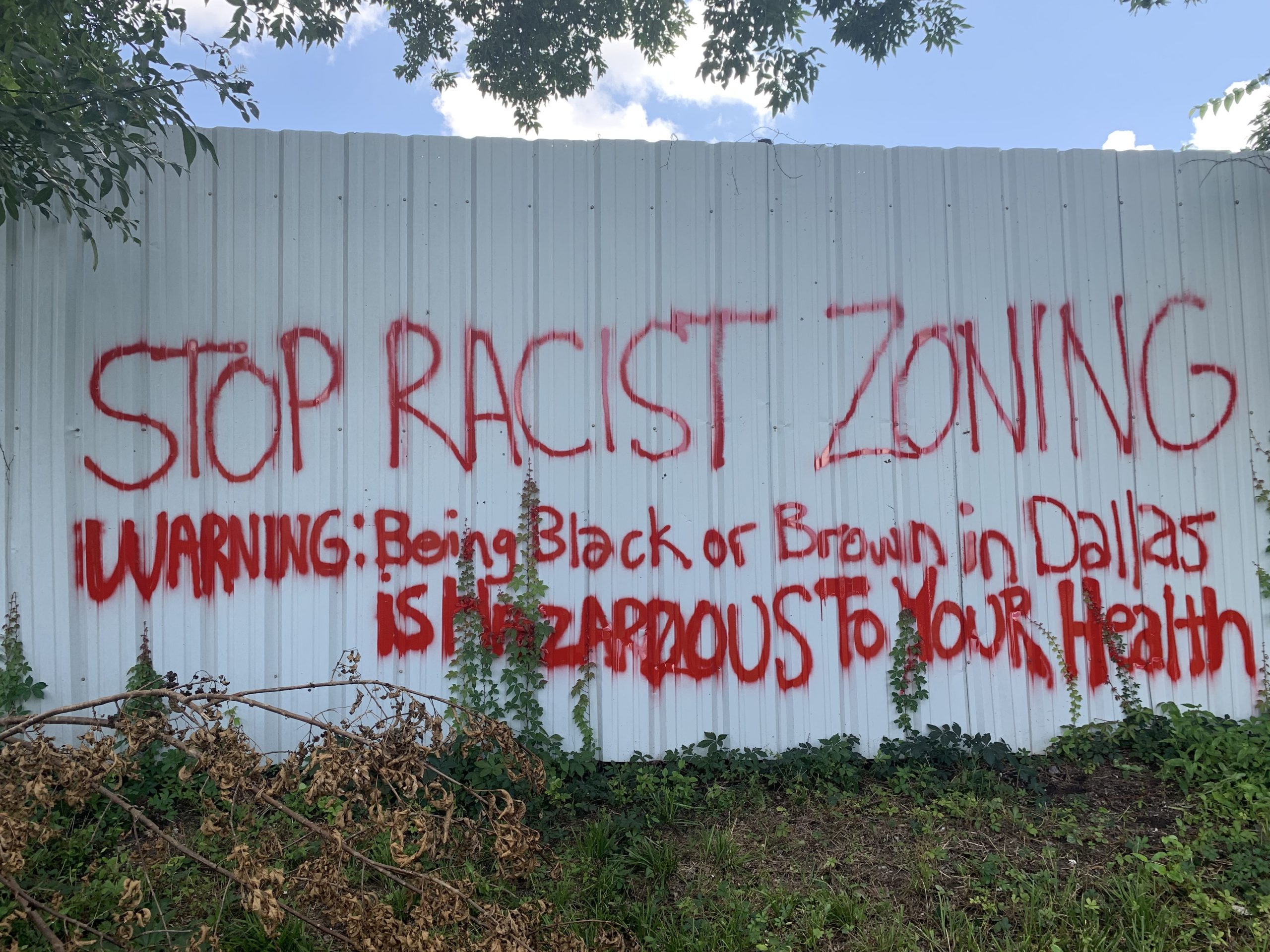
What is It?
For most people, “zoning” isn’t a very interesting topic. How your property is classified by city government is of little concern – until you discover how few protections you have or how close a large polluter can operate near you.
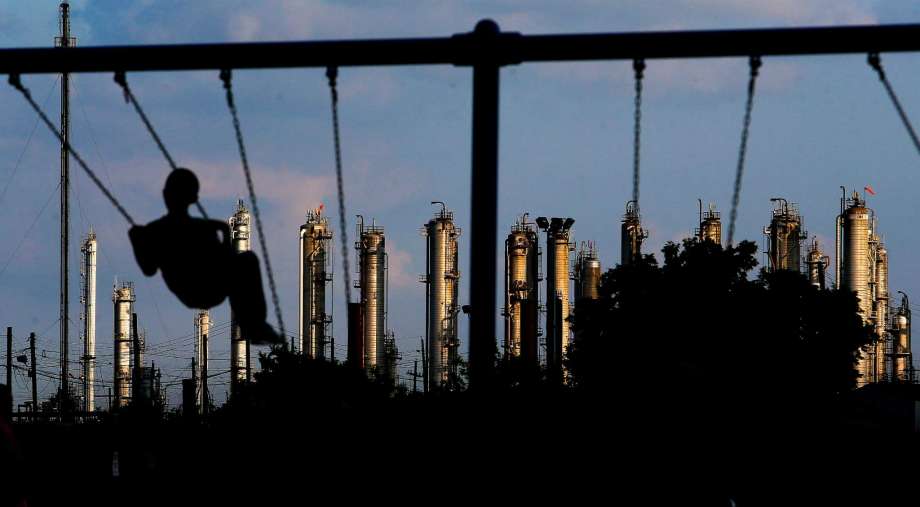 In Dallas as well as most American cities, People of Color have been historically forced by law or practice to live in neighborhoods they had to share with industry. The Trinity River floodplains were used as a large dumping ground for both people and factories deemed “undesirable” by white power brokers.
In Dallas as well as most American cities, People of Color have been historically forced by law or practice to live in neighborhoods they had to share with industry. The Trinity River floodplains were used as a large dumping ground for both people and factories deemed “undesirable” by white power brokers.
While illegal now, that institutionalized discrimination lives on in the form of obsolete racist zoning that still makes Southern Dallas a dumping ground.
Why Do It?
Unless you change the zoning classifications in South Dallas that make it such a haven for dirty industry, the City’s pollution burden will remain concentrated there, stifling economic development and quality of life.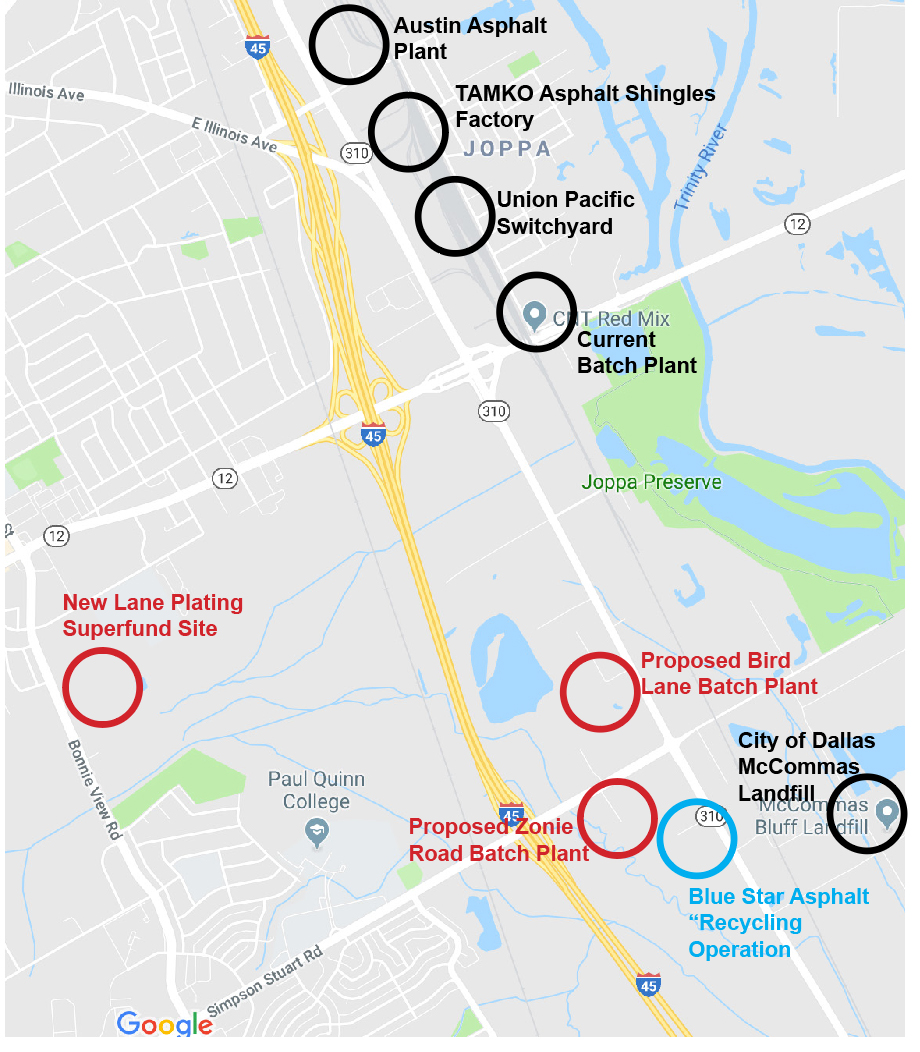 During the last two years Southern Dallas has fought off four proposed batch plants in the same neighborhood because the zoning directs them there. The notorious Shingle Mountain illegal dump took advantage of zoning loopholes to withhold notification of its activities from its neighbors. Instead of playing “whack-a-mole” and having to organize anew against every attempt to site a new polluter there, Southern Dallas residents need to re-write the leftover racist zoning laws and prohibit their part of town from becoming the default Big D dumping ground.
During the last two years Southern Dallas has fought off four proposed batch plants in the same neighborhood because the zoning directs them there. The notorious Shingle Mountain illegal dump took advantage of zoning loopholes to withhold notification of its activities from its neighbors. Instead of playing “whack-a-mole” and having to organize anew against every attempt to site a new polluter there, Southern Dallas residents need to re-write the leftover racist zoning laws and prohibit their part of town from becoming the default Big D dumping ground.
Downwinders is partnering with our friends at Southern Sector Rising and the Inclusive Communities Project to do just that. Dallas is gearing up for a once-in-a-decade review of the City’s MasterPlan that will invite residents to imagine how they want to change their neighborhoods. There’s an opportunity to submit new plans that reverse the racist zoning that plagues the entire Southern part of Dallas.
We’re working with specific Southern Dallas neighborhoods that want to give residents more green space, more buffer zones between themselves and pollution, and even begin proceedings to remove industry from their communities. It’s a 2-3 year process but the end result is increased Environmental Justice in places that desperately need it.
What’s the COVID
Connection?
Bottom: COVID Risk Factors
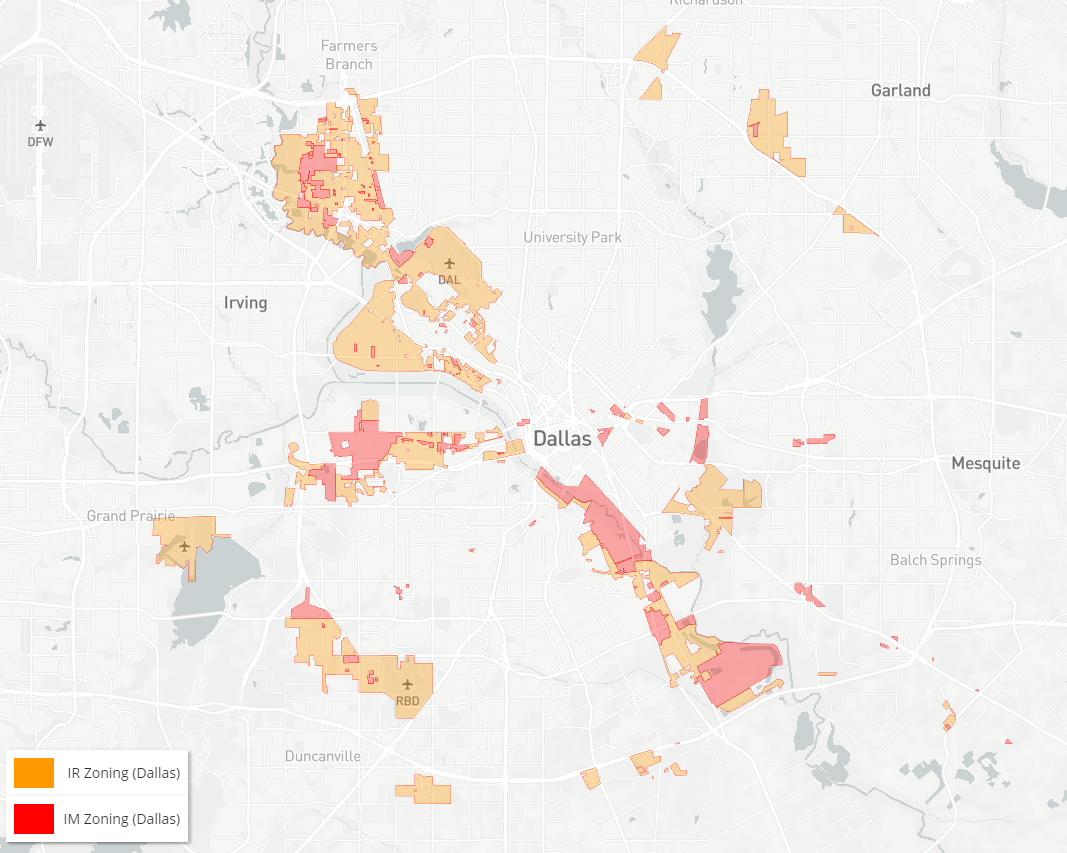 Research done during this pandemic shows Black and Brown residents are being disproportionatey impacted by the COVIC virus.This is being attributed to a number of “pre-existing conditions” in the neighborhoods where they live, including lack of health insurance and health care facilities, poverty and…exposure to air pollution. We know that Black and Brown residents are more likely to be exposed to more and higher levels of air pollution than their white peers.
Research done during this pandemic shows Black and Brown residents are being disproportionatey impacted by the COVIC virus.This is being attributed to a number of “pre-existing conditions” in the neighborhoods where they live, including lack of health insurance and health care facilities, poverty and…exposure to air pollution. We know that Black and Brown residents are more likely to be exposed to more and higher levels of air pollution than their white peers.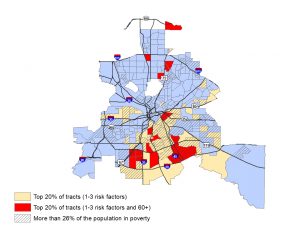 If you change the zoning so that Southern Dallas residents are not living side-by-side with polluters, you reduce their exposure to poisons and improve public health, including making them less vulnerable to viruses like COVID.
If you change the zoning so that Southern Dallas residents are not living side-by-side with polluters, you reduce their exposure to poisons and improve public health, including making them less vulnerable to viruses like COVID.
STATUS?
“forwardDallas!” is the name of the process the City of Dallas is using to redraw its MasterPlan. It was supposed to begin this Spring but may not start until summer. It will involve lots and lots of neighborhood meetings.Downwinders, Southern Sector Rising and the Inclusive 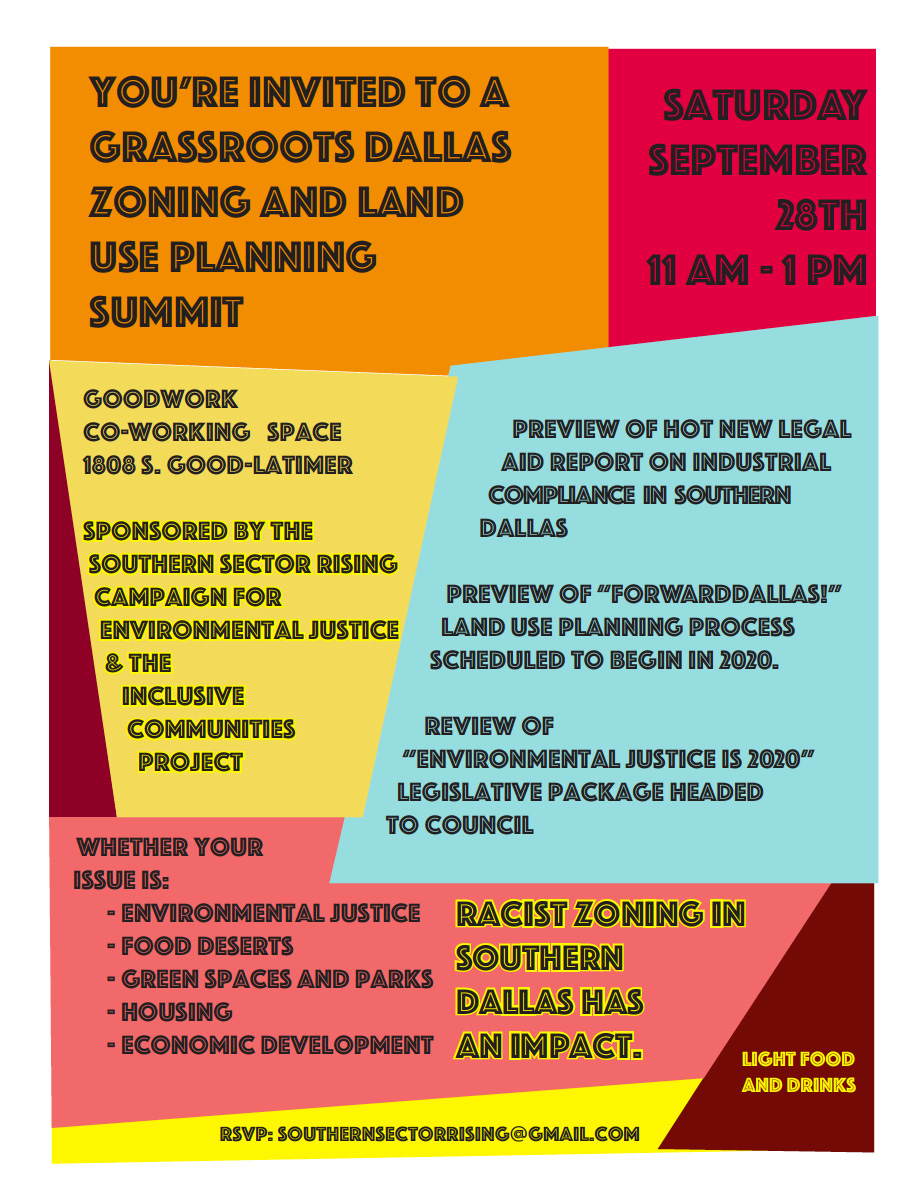 Communities Project isn’t waiting however. We’ve already met with residents’ groups in the Floral Farms and Fruitdale neighborhoods to begin a grassroots planning process. Because of their preparation, these groups will be able to show up to the City meetings with their own plans already developed and ready to be approved. More online meetings are being scheduled for other neighborhoods.
Communities Project isn’t waiting however. We’ve already met with residents’ groups in the Floral Farms and Fruitdale neighborhoods to begin a grassroots planning process. Because of their preparation, these groups will be able to show up to the City meetings with their own plans already developed and ready to be approved. More online meetings are being scheduled for other neighborhoods.
No group has used the “forwardDallas” process to overhaul Dallas zoning in such a comprehensive way. No coordinated effort has ever been focused on this mission. Like so many projects Downwinders takes on, its a “first.” But it’s a chance to make fundamental Change.
This obsolete pattern of “redlining” and segregation lives on in a legacy of racist zoning that still drives polluters to Southern Dallas and along the Trinity River Corridor. Most of the land set aside for heavy industry in Dallas is still south of the River – in predominantly Black and Brown neighborhoods like West Dallas and Joppa.
To make sure Southern Dallas doesn’t remain the City’s dumping ground you have to change the zoning that controls what can go where and next to whom.
PM Pollution and COVID
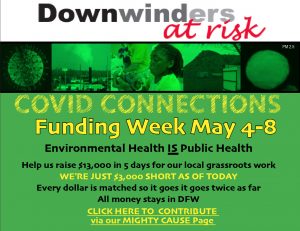
The Massachusetts-based Peace Development Fund has chosen to spotlight the COVID-connected work of
Downwinders at Risk and 12 other groups
across the country this week in order to help raise funds for that work.
As of late last night successfully met our original goal of $10,000. THANK YOU. So now we’re setting our sights on trying to raise an additional $3,000 by Friday. All of this money goes to local DFW program work in front line communities that are most vulnerable to
COVID infection.
Help us help more people.
CONTRIBUTE HERE
Thanks
______________________________________
COVID Connects:
Particulate Matter Air Pollution
to Increased Risk of Disease
What is It?
You’ve heard of the dangers of second-hand smoke? PM is industrial second-hand smoke.
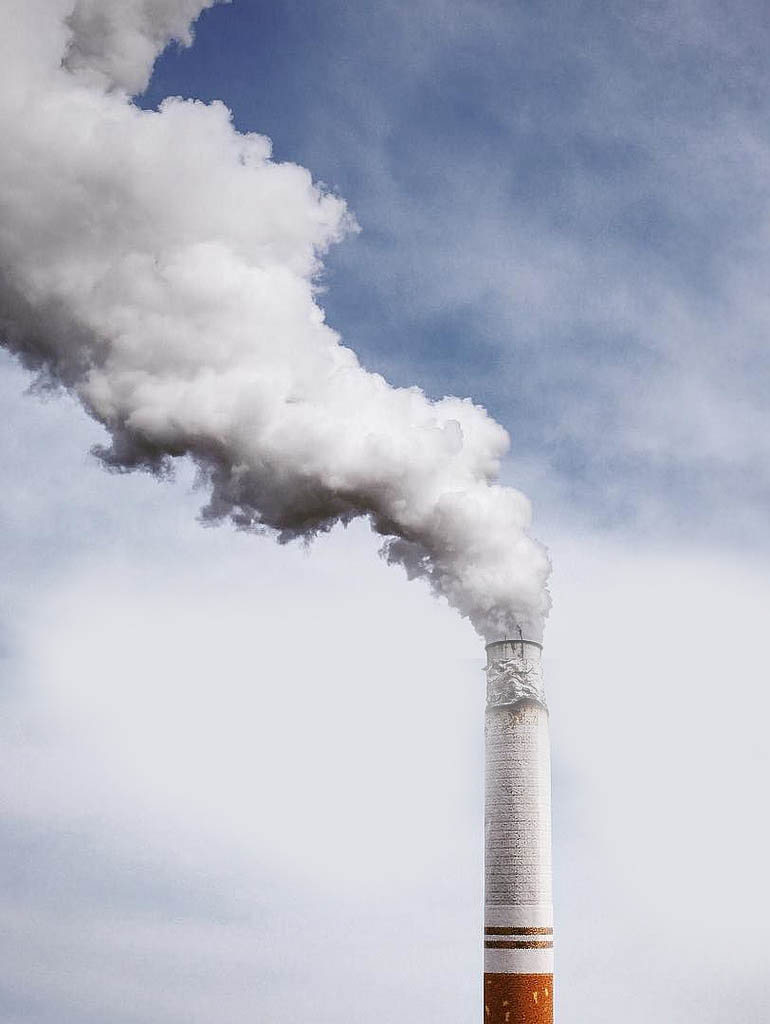 Research over the last decade connects PM pollution with not just lung and coronary diseases, but IQ loss, Autism, Dementia, Parkinson’s Disease, Diabetes, Immune-Deficiency, depression, and blindness. Research also shows Black and Brown residents are exposed to more PM pollution and at higher levels than most of their white peers.
Research over the last decade connects PM pollution with not just lung and coronary diseases, but IQ loss, Autism, Dementia, Parkinson’s Disease, Diabetes, Immune-Deficiency, depression, and blindness. Research also shows Black and Brown residents are exposed to more PM pollution and at higher levels than most of their white peers.re-thinking freeways. We’re in the weeds with neighborhood groups plotting new land use plans separating PM sources from people, or eliminating them altogether. In essence, we’re conducting an anti-smoking campaign aimed at machines.
Why Do It?
Sources of PM pollution are controlled by local gov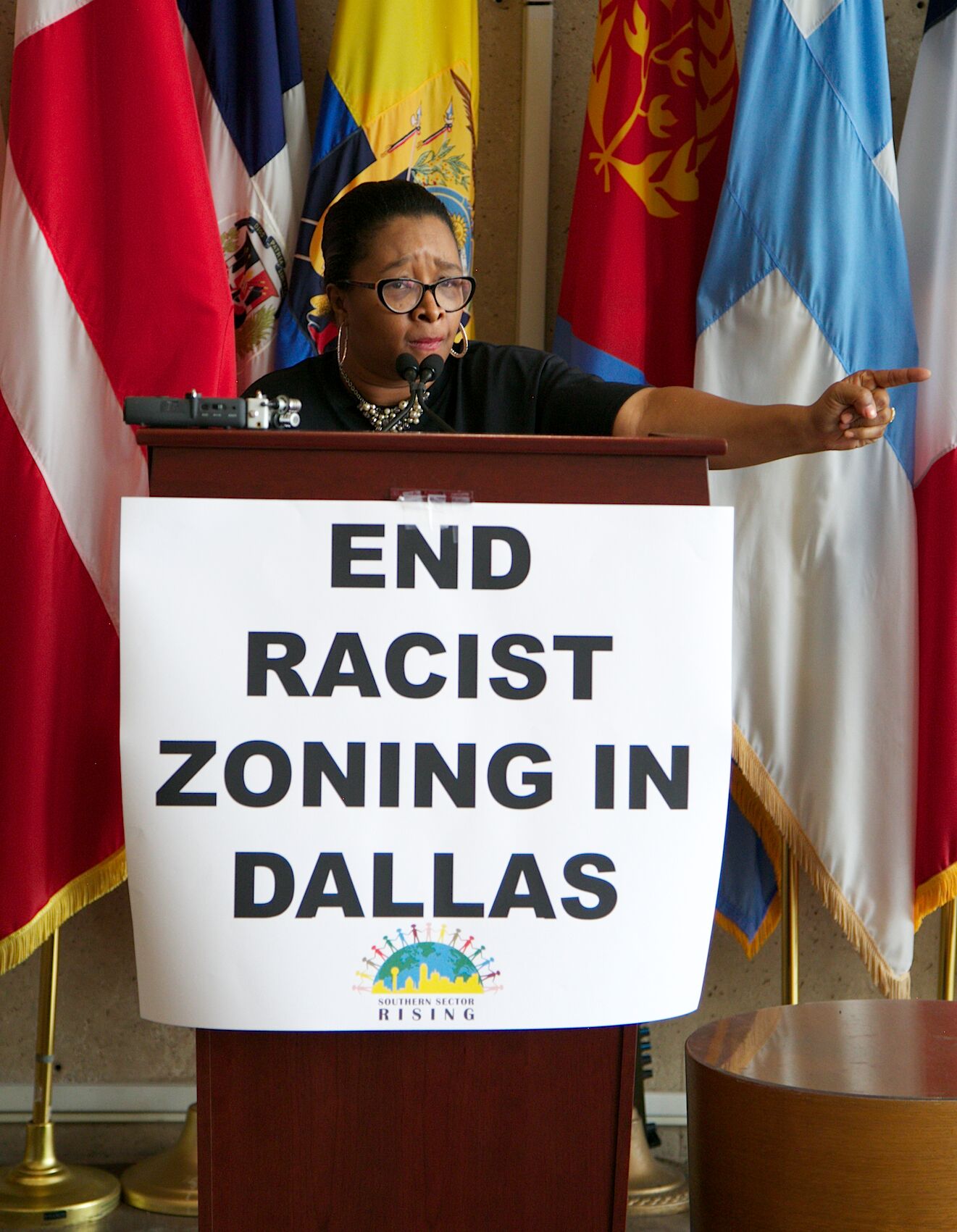 ernments through zoning and other municipal and county policies. As a local group, North Texas is where Downwinders is most effective in making change.
ernments through zoning and other municipal and county policies. As a local group, North Texas is where Downwinders is most effective in making change.
After the 2016 presidential election it was clear we couldn’t make progress on DFW chronic smog without good faith partners at EPA. So we turned our attention to addressing the most insidious air pollutant that can be controlled by local action. We found we could have a big impact on how these very small toxic particles are affecting DFW residents.
What’s the COVID Connection?
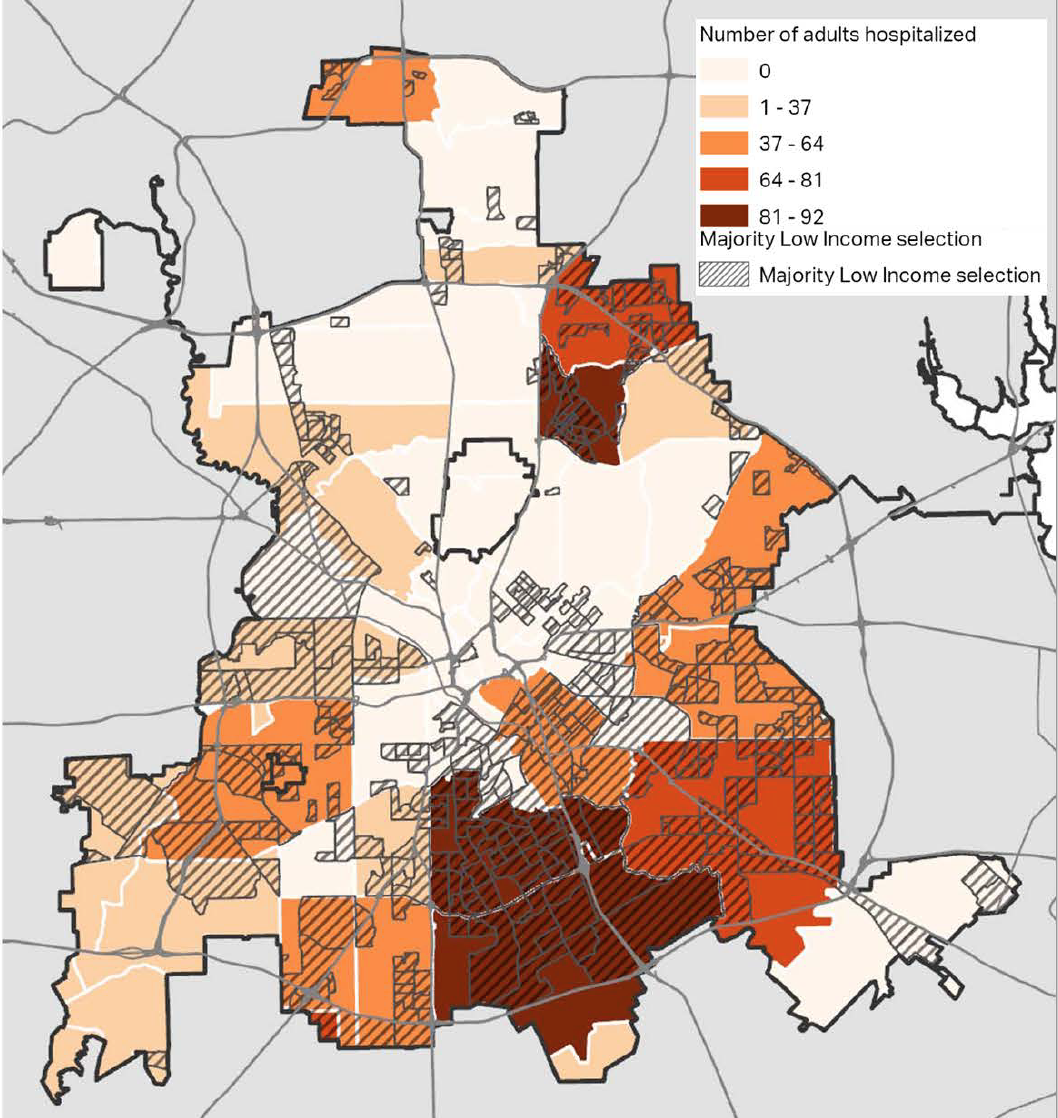
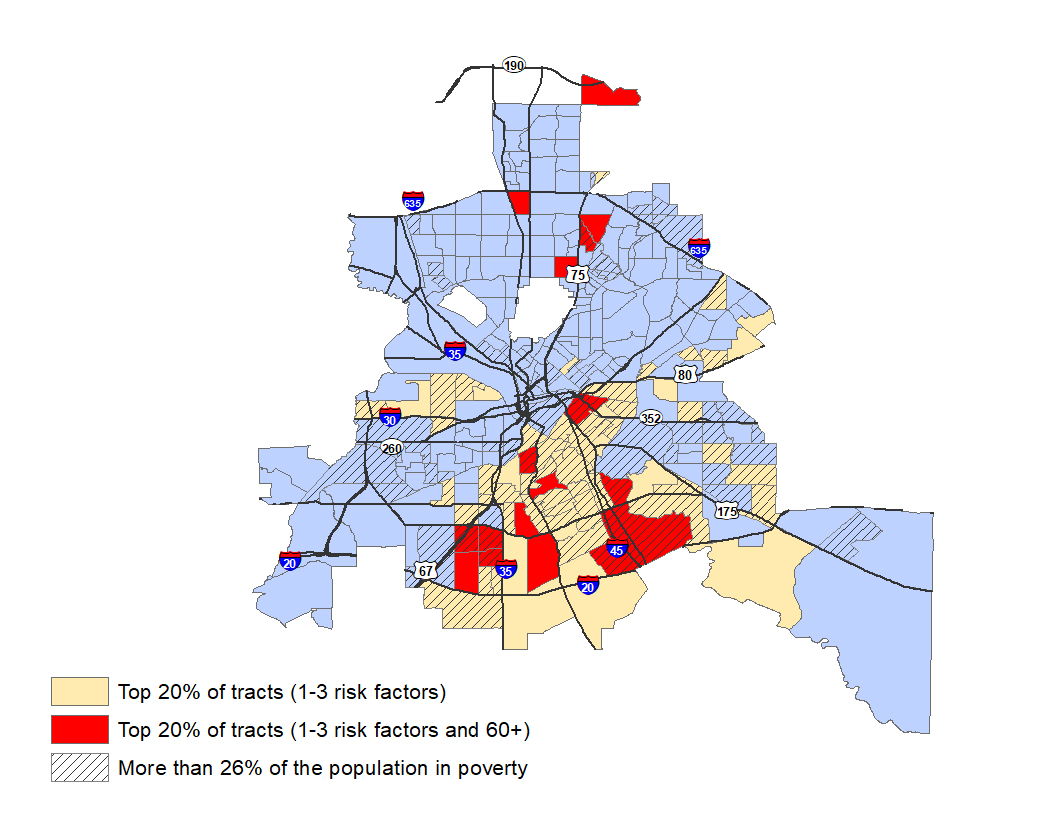
STATUS?
Since 2017 Downwinders has purchased five portable Aeroqual PM 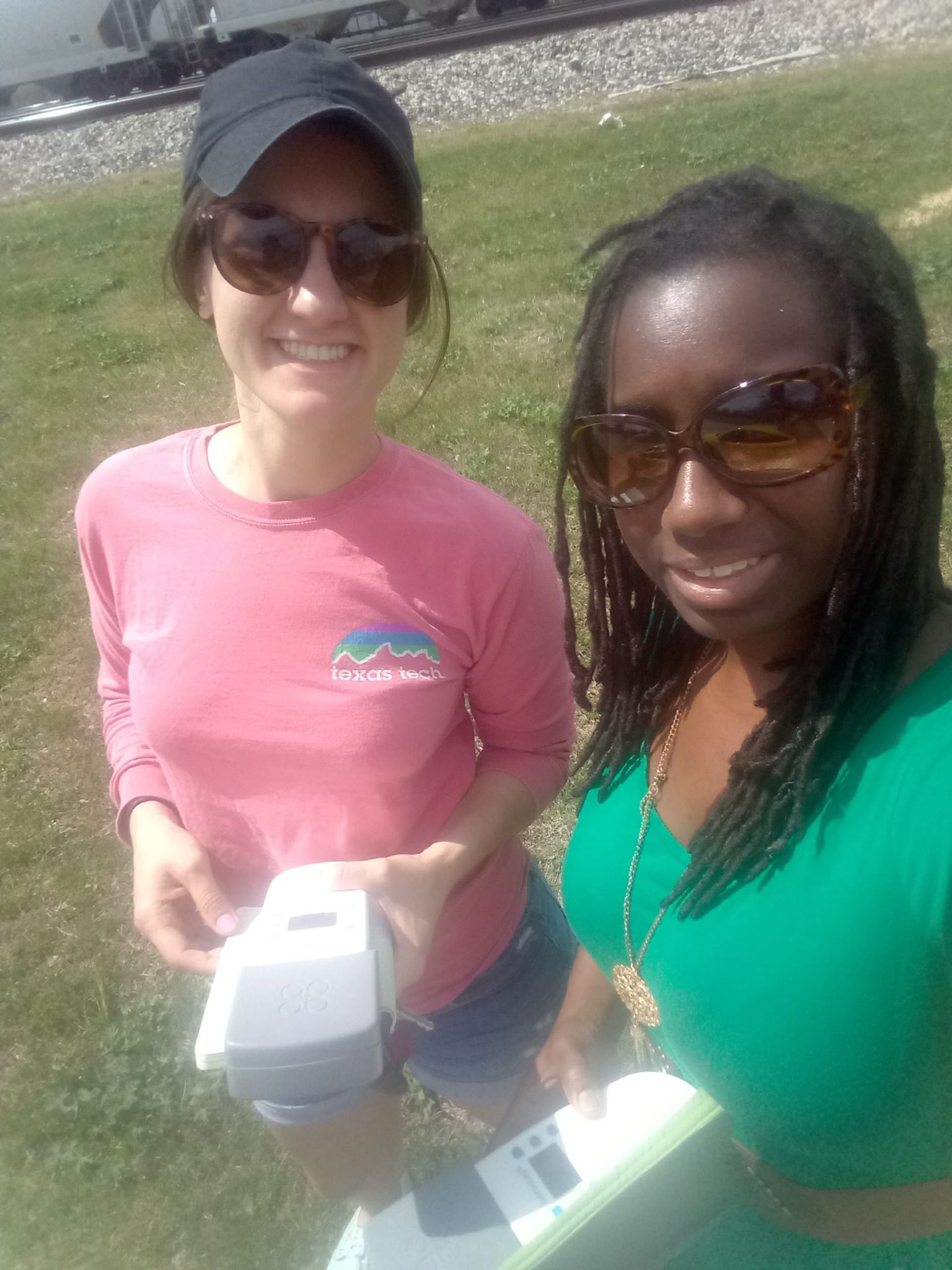 monitors that have been used to track PM Air pollution in DFW and identify hot spots. These portable monitors were the first to record PM levels in the Joppa community in Dallas and the Shingle Mountain illegal dump. We also offer free training in how to use these monitors.With UTD and others, Downwinders is building a 100 + PM monitor network for DFW to track the pollutant in real time across the region.
monitors that have been used to track PM Air pollution in DFW and identify hot spots. These portable monitors were the first to record PM levels in the Joppa community in Dallas and the Shingle Mountain illegal dump. We also offer free training in how to use these monitors.With UTD and others, Downwinders is building a 100 + PM monitor network for DFW to track the pollutant in real time across the region.
Dallas’ climate plan sets goals for electrification of the DART bus fleet by 2040 but other cities are moving faster.
For the last three years debate over the siting of proposed new batch plants has raised the profile of Particulate Matter at Dallas City Hall and around North Texas.
Environmental Organizing on Giving Day 2020
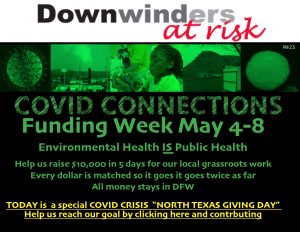
TUESDAY GIVING DAY UPDATE:
We’re over half-way to our goal of $10,000.
Please help us get there today.
1. Today the Communities Foundation of Texas is sponsoring a special COVID crisis North Texas Giving Day for DFW non-profits.
2. The Peace Development Fund has chosen to spotlight the COVID-connected work of Downwinders and 12 other groups across the country to help during the crisis.
The Fund and generous donors are matching every dollar we raise this week up to $10,000 – that’s a $20,00,000 grant on the line.
We have until Friday to raise the $10,000.
You can help us reach this goal right now by contributing at our North Texas Giving Day Page or the Mighty Cause pay portal the Development Fund has set up for us.
Thanks for your support,


Evelyn Mayo, Chair
____________________________________
COVID Connects:
Community Organizing to
Environmental Health
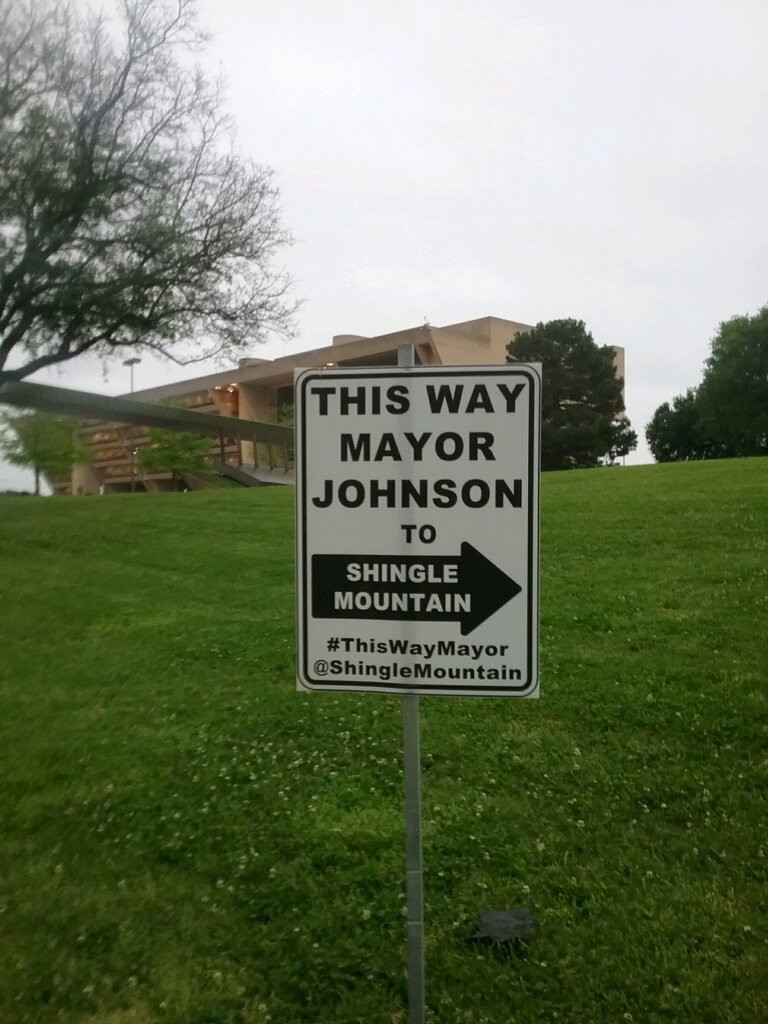 200 signs like these went up across Dallas on Earth Day 2020. Major Johnson has yet to visit or speak publicly about the highest profile environmental justice scandal since the West Dallas RSR lead smelter Superfund site 25 years ago.
200 signs like these went up across Dallas on Earth Day 2020. Major Johnson has yet to visit or speak publicly about the highest profile environmental justice scandal since the West Dallas RSR lead smelter Superfund site 25 years ago.
What is It?
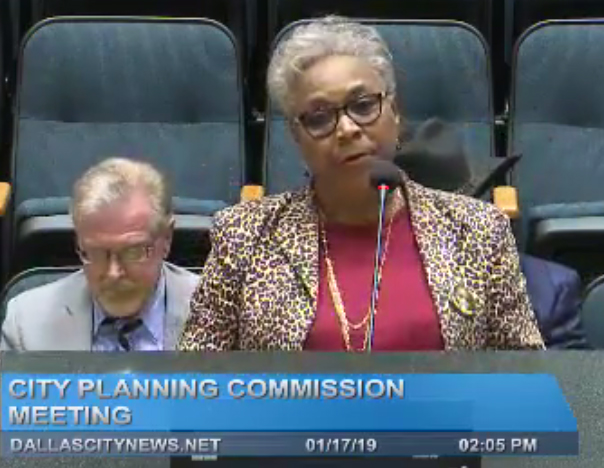 Downwinders provides much needed basic organizing resources to local grassroots environmental health fights.We offer the only full time staff devoted to applying community organizing principles to assist groups. We provide start-up funding for fliers and other materials. We’re the only citizens group that has the technology to take air pollution samples…and the classes to teach you how to do it as well. Mostly, we give those in need the attention they’re not getting from officials or anyone else.
Downwinders provides much needed basic organizing resources to local grassroots environmental health fights.We offer the only full time staff devoted to applying community organizing principles to assist groups. We provide start-up funding for fliers and other materials. We’re the only citizens group that has the technology to take air pollution samples…and the classes to teach you how to do it as well. Mostly, we give those in need the attention they’re not getting from officials or anyone else.
Most importantly, we show how to use a fight to change the system that produced the problem. The most recent example is the Shingle Mountain illegal dump and the group Southern Sector Rising that was created to shut it down and clean it up.
Why Do It?
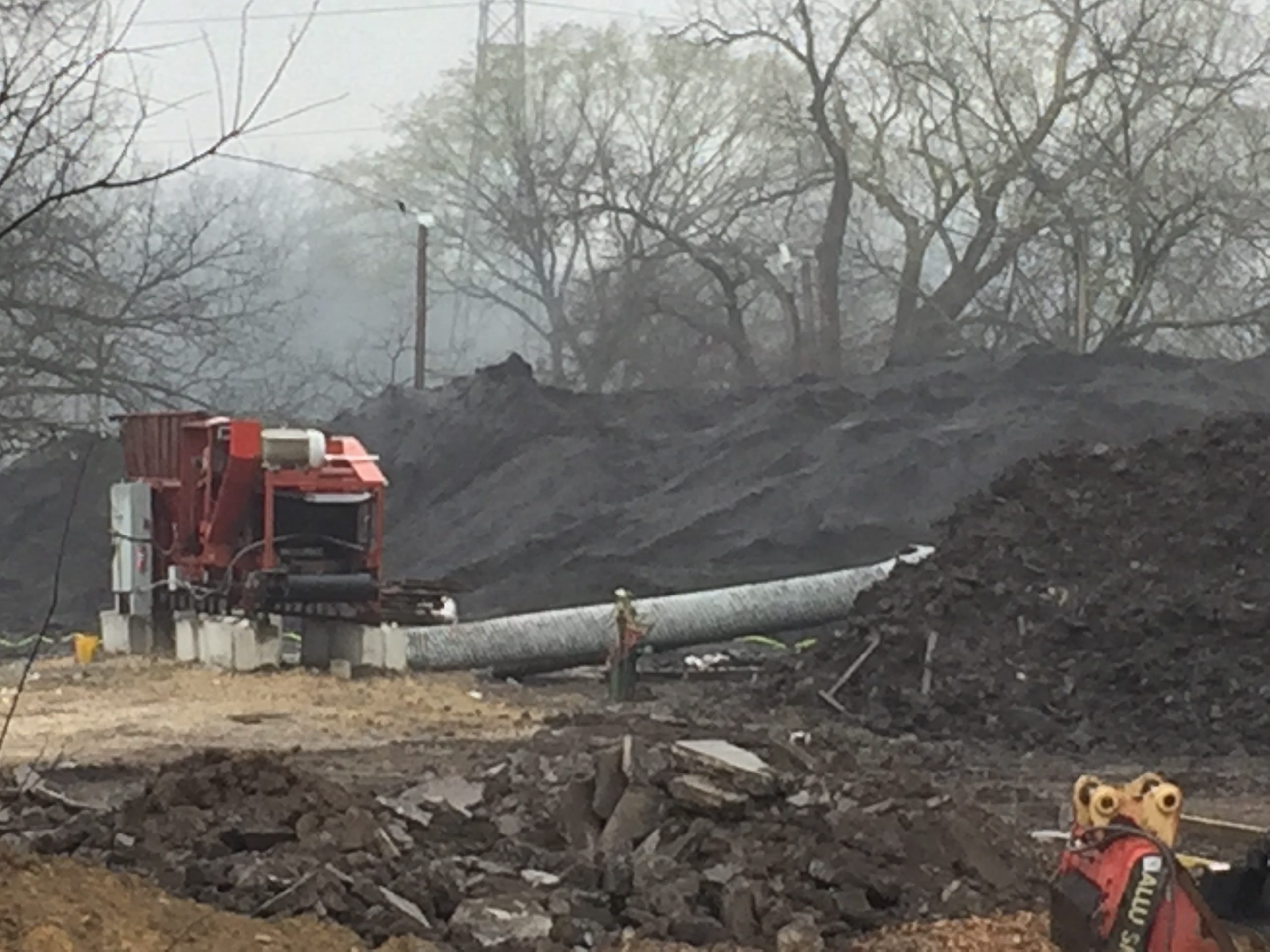 Shingle Mountain for almost a year when she finally found Downwinders. It took us only three months of organizing with Ms. Jackson to get the City to reverse itself and file suit against the site’s operators to close the site.Out of that effort sprang Southern Sector Rising, a group aimed at not only seeking justice for Shingle Mountain residents but making sure Dallas implemented a citywide Environmental Justice agenda. Part of that agenda, announced on March 20th 2019 at a City Hall news conference, was the restoration of the Dallas Environmental Health Commission and a Environmental Equity Provision that would steer polluters away from already over-polluted neighborhoods.
Shingle Mountain for almost a year when she finally found Downwinders. It took us only three months of organizing with Ms. Jackson to get the City to reverse itself and file suit against the site’s operators to close the site.Out of that effort sprang Southern Sector Rising, a group aimed at not only seeking justice for Shingle Mountain residents but making sure Dallas implemented a citywide Environmental Justice agenda. Part of that agenda, announced on March 20th 2019 at a City Hall news conference, was the restoration of the Dallas Environmental Health Commission and a Environmental Equity Provision that would steer polluters away from already over-polluted neighborhoods.
Southern Sector Rising and Downwinders are using the example of Shingle Mountain to pass policies aimed at preventing new Shingle Mountains.
What’s the COVID Connection?
In 2020 it seems obvious that municipal governments need to address environmental health issues. But Dallas ditched it’s original Environmental Health Commission a decade ago.
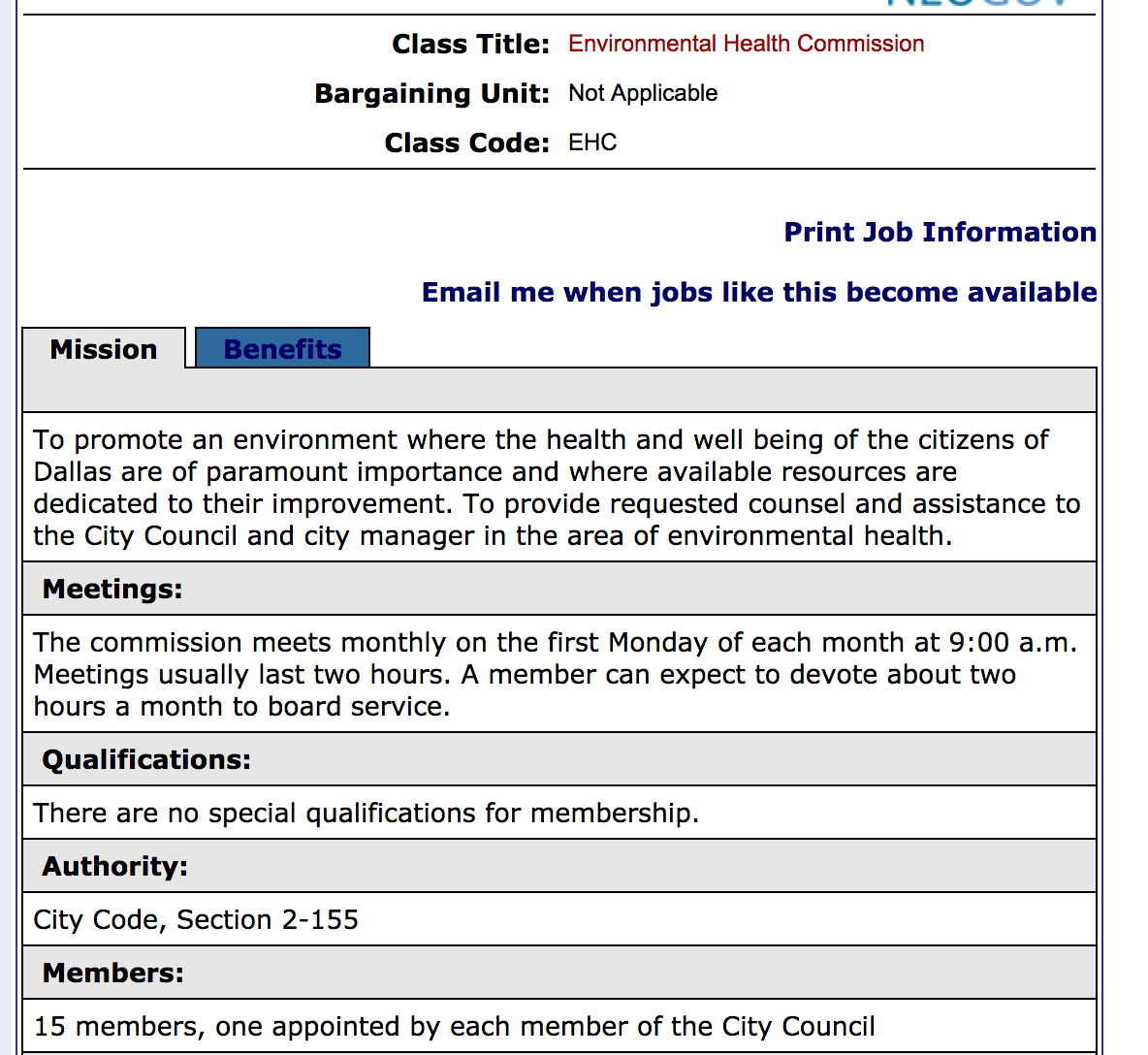 Formed in the wake of the 1980’s West Dallas and East Oak Cliff Lead smelter fights, the Health Commission was a citizen-based watchdog. It recommended the effective banning of hazardous and medical waste incineration in the City and wrote a tough anti-smoking policy before the Council disbanded it.
Formed in the wake of the 1980’s West Dallas and East Oak Cliff Lead smelter fights, the Health Commission was a citizen-based watchdog. It recommended the effective banning of hazardous and medical waste incineration in the City and wrote a tough anti-smoking policy before the Council disbanded it.
Had the Commission been around in 2017, it’s likely the Shingle Mountain dump would have shown-up on Dallas City Hall’s radar screens a lot sooner than it did when a reporter had to tell officials about the outrage a year later.
And an “equitable” economic development policy would end the practice of illegal dumpers and grifters targeting Southern Dallas for their schemes. That pattern of “development” is one reason why residents find themselves more vulnerable to COVID.
Before the virus, City Hall policy avoided environmental health issues. This pandemic shows why it must embrace and plan for them.
STATUS?
Southern Sector Rising has asked that restoration of the Dallas Environmental Health Commission be part of the City’s new climate plan, up for a vote on May 27th. Despite 10 of the current 15 Dallas City Council members having endorsed the idea only last Spring, there’s been no public movement toward adoption. 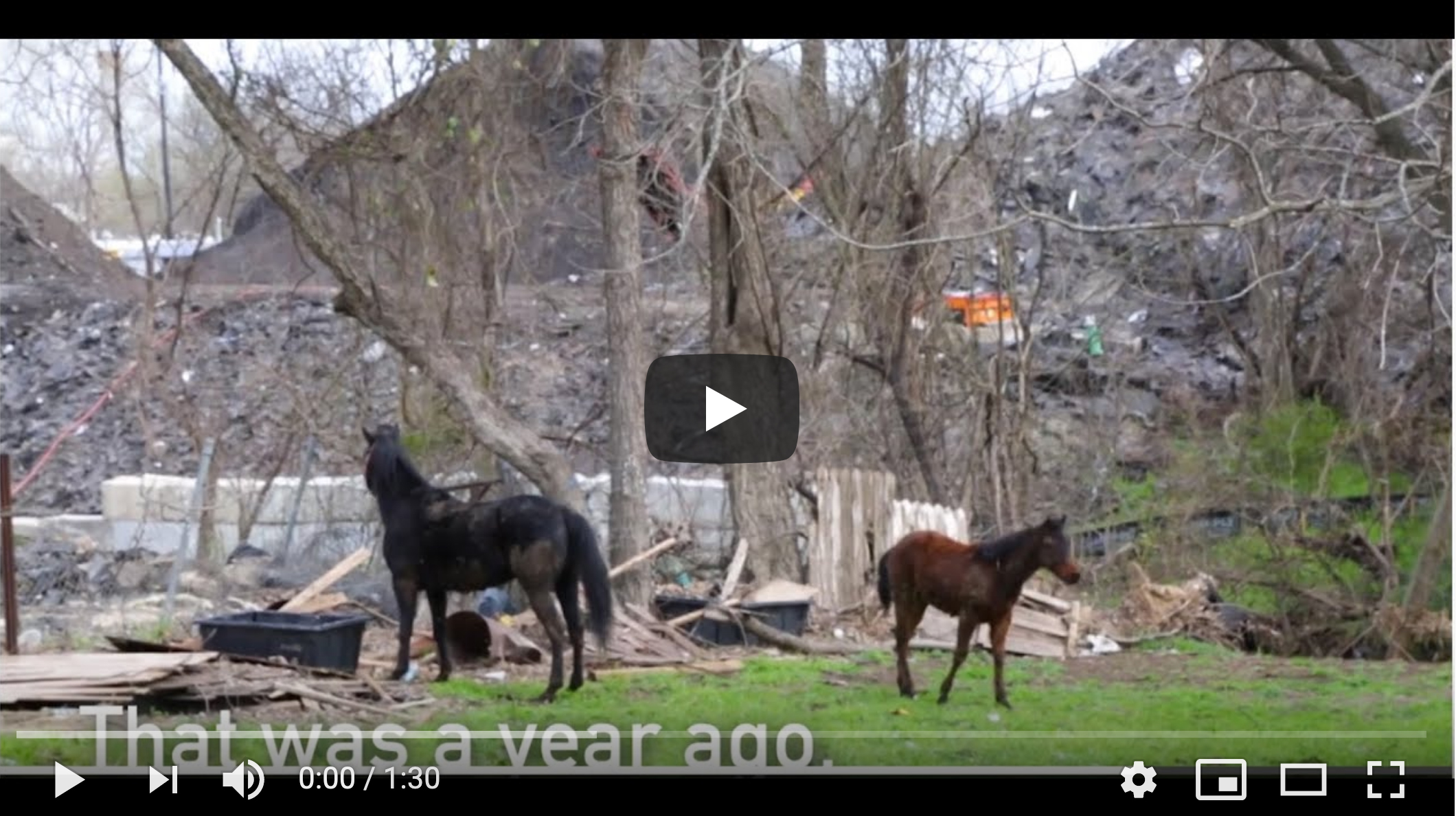
SSR won the closing of Shingle Mountain as an active operation, but the dump itself remains an on-going public health crisis in its own right. Over 100,000 tons of petroleum based asphalt shingles
are stacked 6-7 stories high next door to Dallas residents, including families with children.
Despite being invited and holding office for a year, Dallas Mayor Eric Johnson has never visited or commented publicly on Shingle Mountain.
over 200 “directional aids” went up around

